
1 UNITED STATES OF AMERICA BUREAU OF CONSUMER FINANCIAL PROTECTION ADMINISTRATIVE PROCEEDING File No. 2018-BCFP-0001 In the Matter of: CONSENT ORDER WELLS FARGO BANK, N.A. The Bureau of Consumer Financial Protection (Bureau) has reviewed aspects of the following conduct of Wells Fargo Bank, N.A. (Respondent, as defined below): (1) charging fees for rate-lock extensions in connection with residential-mortgage lending; and (2) force-placing collateral-protection insurance (Force-Placed Insurance, as defined below) on consumers’ vehicles for auto loans that it originated or acquired. The Bureau has identified the following violations of law: (1) Respondent unfairly failed to follow the mortgage-interest-rate-lock process it explained to some prospective borrowers; and (2) Respondent operated its Force-Placed Insurance program in an unfair manner. The Bureau issues this Consent Order (Consent Order) under authority granted by §§ 1053 and 1055 of the Consumer Financial Protection Act of 2010 (CFPA), 12 U.S.C. §§ 5563, 5565. Respondent has previously identified and reported to the Bureau certain information about the deficiencies described in this Consent Order. Respondent has discontinued the practices that led to the deficiencies, including, as of September 30, 2016, the placement of Force-Placed Insurance, as defined below. Further, Respondent 2018-BCFP-0001 Document 1 Filed 04/20/2018 Page 1 of 35 Exhibit 99.2
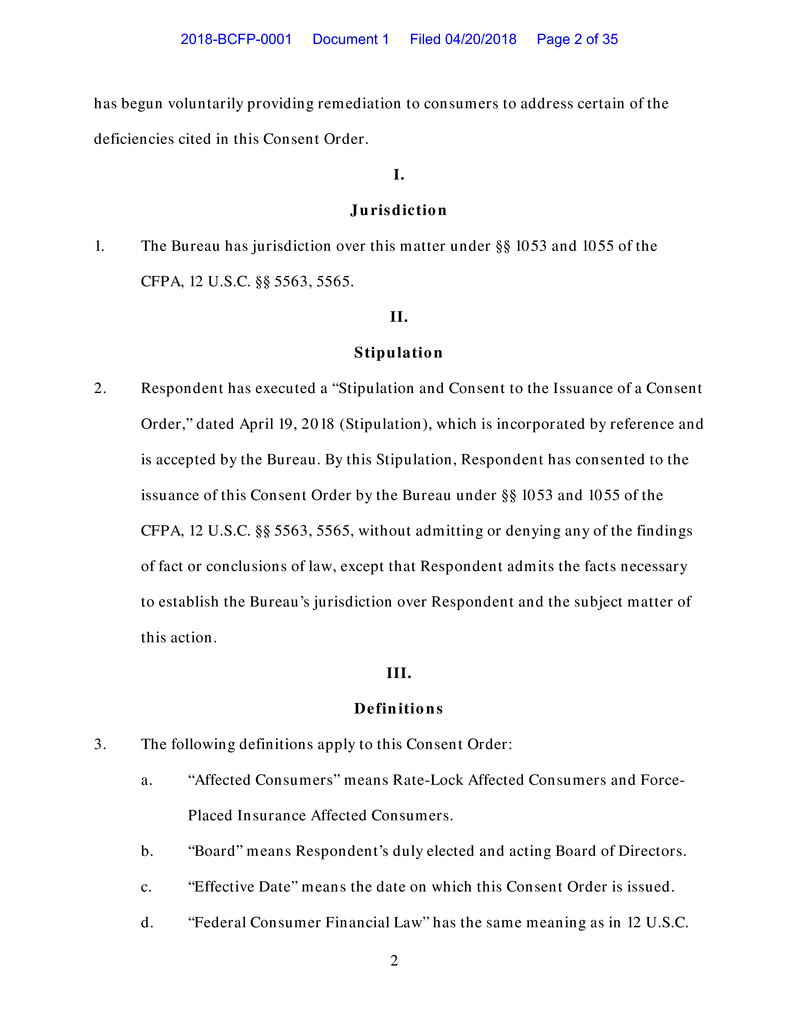
2 has begun voluntarily providing remediation to consumers to address certain of the deficiencies cited in this Consent Order. I. Jurisdiction 1. The Bureau has jurisdiction over this matter under §§ 1053 and 1055 of the CFPA, 12 U.S.C. §§ 5563, 5565. II. Stipulation 2. Respondent has executed a “Stipulation and Consent to the Issuance of a Consent Order,” dated April 19, 2018 (Stipulation), which is incorporated by reference and is accepted by the Bureau. By this Stipulation, Respondent has consented to the issuance of this Consent Order by the Bureau under §§ 1053 and 1055 of the CFPA, 12 U.S.C. §§ 5563, 5565, without admitting or denying any of the findings of fact or conclusions of law, except that Respondent admits the facts necessary to establish the Bureau’s jurisdiction over Respondent and the subject matter of this action. III. Definitions 3. The following definitions apply to this Consent Order: a. “Affected Consumers” means Rate-Lock Affected Consumers and Force- Placed Insurance Affected Consumers. b. “Board” means Respondent’s duly elected and acting Board of Directors. c. “Effective Date” means the date on which this Consent Order is issued. d. “Federal Consumer Financial Law” has the same meaning as in 12 U.S.C. 2018-BCFP-0001 Document 1 Filed 04/20/2018 Page 2 of 35
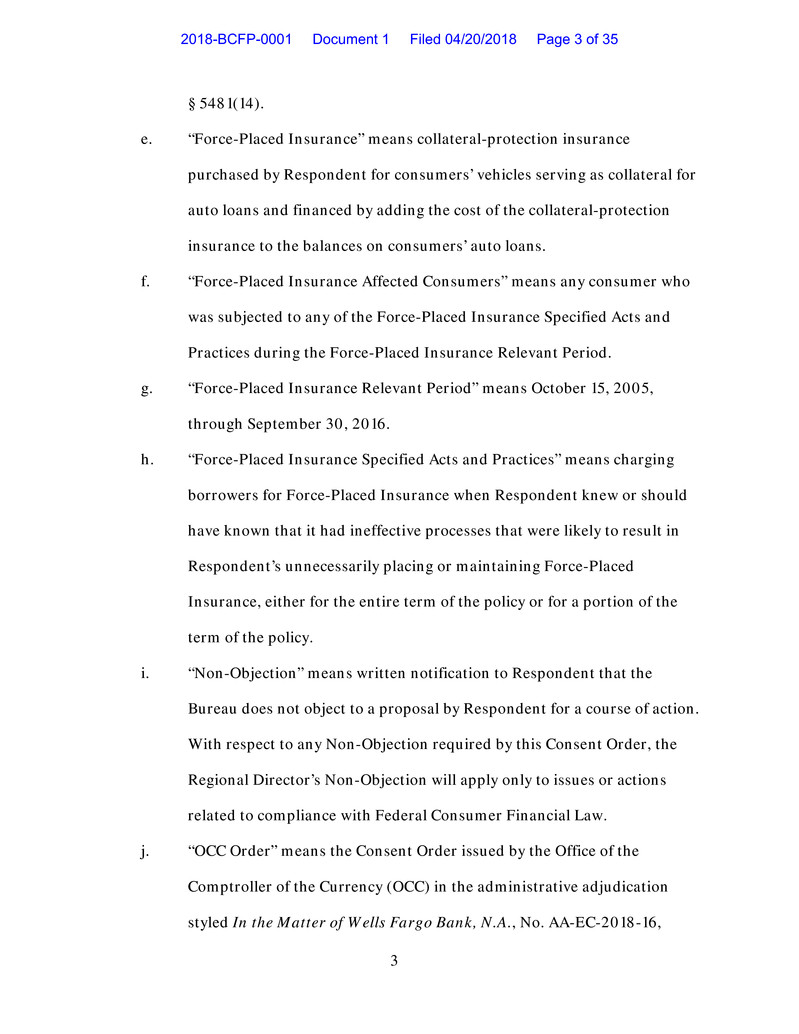
3 § 5481(14). e. “Force-Placed Insurance” means collateral-protection insurance purchased by Respondent for consumers’ vehicles serving as collateral for auto loans and financed by adding the cost of the collateral-protection insurance to the balances on consumers’ auto loans. f. “Force-Placed Insurance Affected Consumers” means any consumer who was subjected to any of the Force-Placed Insurance Specified Acts and Practices during the Force-Placed Insurance Relevant Period. g. “Force-Placed Insurance Relevant Period” means October 15, 2005, through September 30, 2016. h. “Force-Placed Insurance Specified Acts and Practices” means charging borrowers for Force-Placed Insurance when Respondent knew or should have known that it had ineffective processes that were likely to result in Respondent’s unnecessarily placing or maintaining Force-Placed Insurance, either for the entire term of the policy or for a portion of the term of the policy. i. “Non-Objection” means written notification to Respondent that the Bureau does not object to a proposal by Respondent for a course of action. With respect to any Non-Objection required by this Consent Order, the Regional Director’s Non-Objection will apply only to issues or actions related to compliance with Federal Consumer Financial Law. j. “OCC Order” means the Consent Order issued by the Office of the Comptroller of the Currency (OCC) in the administrative adjudication styled In the Matter of Wells Fargo Bank, N.A., No. AA-EC-2018-16, 2018-BCFP-0001 Document 1 Filed 04/20/2018 Page 3 of 35
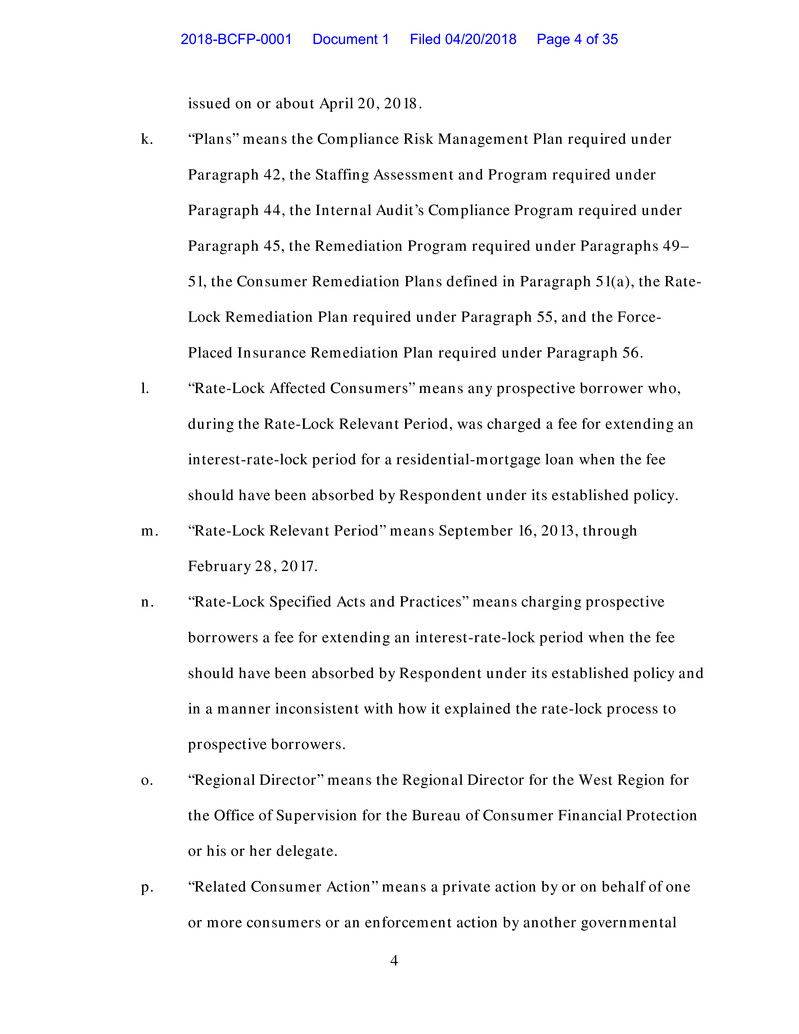
4 issued on or about April 20, 2018. k. “Plans” means the Compliance Risk Management Plan required under Paragraph 42, the Staffing Assessment and Program required under Paragraph 44, the Internal Audit’s Compliance Program required under Paragraph 45, the Remediation Program required under Paragraphs 49– 51, the Consumer Remediation Plans defined in Paragraph 51(a), the Rate- Lock Remediation Plan required under Paragraph 55, and the Force- Placed Insurance Remediation Plan required under Paragraph 56. l. “Rate-Lock Affected Consumers” means any prospective borrower who, during the Rate-Lock Relevant Period, was charged a fee for extending an interest-rate-lock period for a residential-mortgage loan when the fee should have been absorbed by Respondent under its established policy. m. “Rate-Lock Relevant Period” means September 16, 2013, through February 28, 2017. n. “Rate-Lock Specified Acts and Practices” means charging prospective borrowers a fee for extending an interest-rate-lock period when the fee should have been absorbed by Respondent under its established policy and in a manner inconsistent with how it explained the rate-lock process to prospective borrowers. o. “Regional Director” means the Regional Director for the West Region for the Office of Supervision for the Bureau of Consumer Financial Protection or his or her delegate. p. “Related Consumer Action” means a private action by or on behalf of one or more consumers or an enforcement action by another governmental 2018-BCFP-0001 Document 1 Filed 04/20/2018 Page 4 of 35
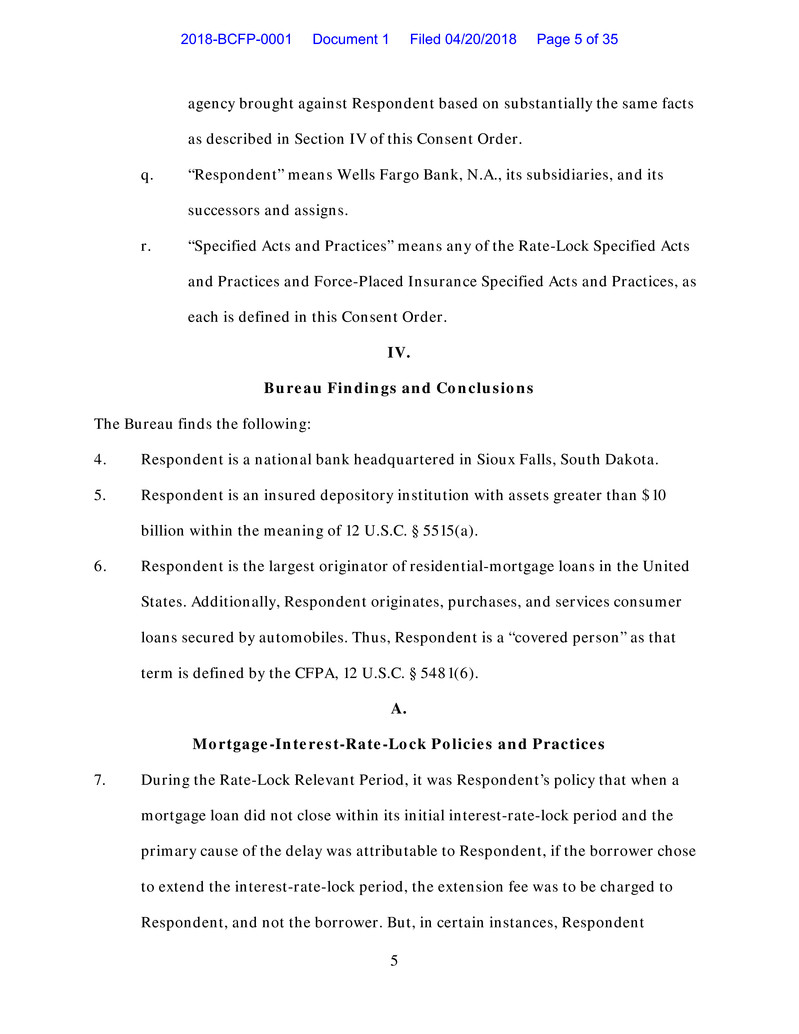
5 agency brought against Respondent based on substantially the same facts as described in Section IV of this Consent Order. q. “Respondent” means Wells Fargo Bank, N.A., its subsidiaries, and its successors and assigns. r. “Specified Acts and Practices” means any of the Rate-Lock Specified Acts and Practices and Force-Placed Insurance Specified Acts and Practices, as each is defined in this Consent Order. IV. Bureau Findings and Conclusions The Bureau finds the following: 4. Respondent is a national bank headquartered in Sioux Falls, South Dakota. 5. Respondent is an insured depository institution with assets greater than $10 billion within the meaning of 12 U.S.C. § 5515(a). 6. Respondent is the largest originator of residential-mortgage loans in the United States. Additionally, Respondent originates, purchases, and services consumer loans secured by automobiles. Thus, Respondent is a “covered person” as that term is defined by the CFPA, 12 U.S.C. § 5481(6). A. Mortgage-Interest-Rate-Lock Policies and Practices 7. During the Rate-Lock Relevant Period, it was Respondent’s policy that when a mortgage loan did not close within its initial interest-rate-lock period and the primary cause of the delay was attributable to Respondent, if the borrower chose to extend the interest-rate-lock period, the extension fee was to be charged to Respondent, and not the borrower. But, in certain instances, Respondent 2018-BCFP-0001 Document 1 Filed 04/20/2018 Page 5 of 35
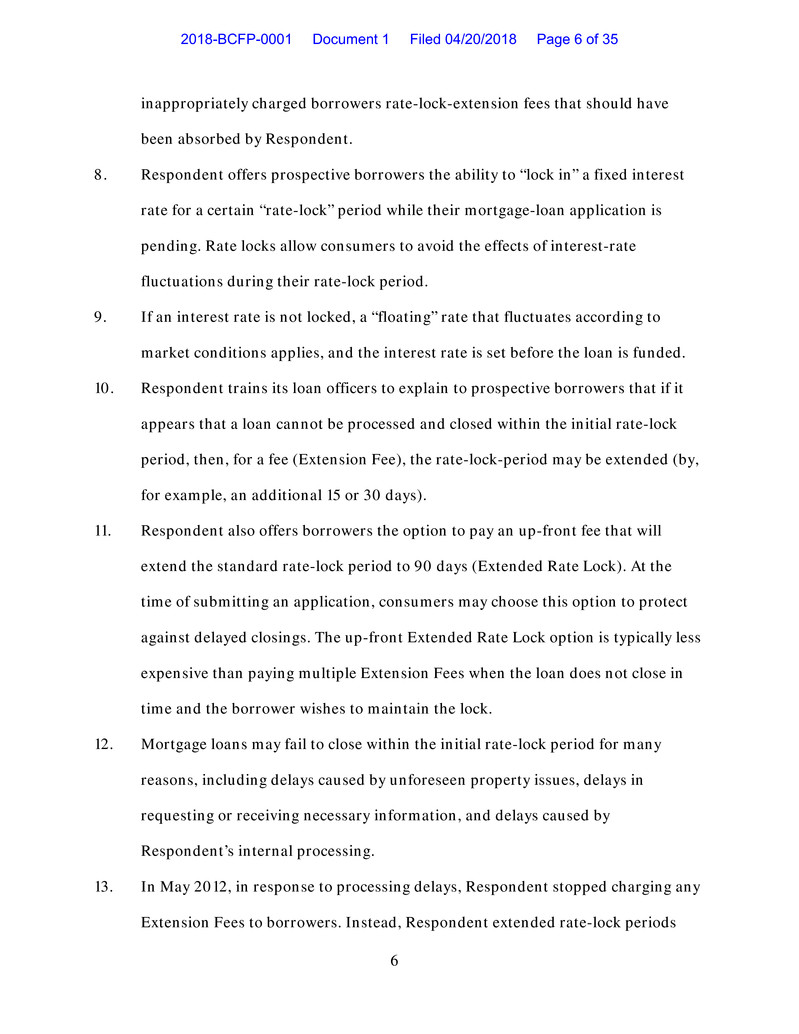
6 inappropriately charged borrowers rate-lock-extension fees that should have been absorbed by Respondent. 8. Respondent offers prospective borrowers the ability to “lock in” a fixed interest rate for a certain “rate-lock” period while their mortgage-loan application is pending. Rate locks allow consumers to avoid the effects of interest-rate fluctuations during their rate-lock period. 9. If an interest rate is not locked, a “floating” rate that fluctuates according to market conditions applies, and the interest rate is set before the loan is funded. 10. Respondent trains its loan officers to explain to prospective borrowers that if it appears that a loan cannot be processed and closed within the initial rate-lock period, then, for a fee (Extension Fee), the rate-lock-period may be extended (by, for example, an additional 15 or 30 days). 11. Respondent also offers borrowers the option to pay an up-front fee that will extend the standard rate-lock period to 90 days (Extended Rate Lock). At the time of submitting an application, consumers may choose this option to protect against delayed closings. The up-front Extended Rate Lock option is typically less expensive than paying multiple Extension Fees when the loan does not close in time and the borrower wishes to maintain the lock. 12. Mortgage loans may fail to close within the initial rate-lock period for many reasons, including delays caused by unforeseen property issues, delays in requesting or receiving necessary information, and delays caused by Respondent’s internal processing. 13. In May 2012, in response to processing delays, Respondent stopped charging any Extension Fees to borrowers. Instead, Respondent extended rate-lock periods 2018-BCFP-0001 Document 1 Filed 04/20/2018 Page 6 of 35
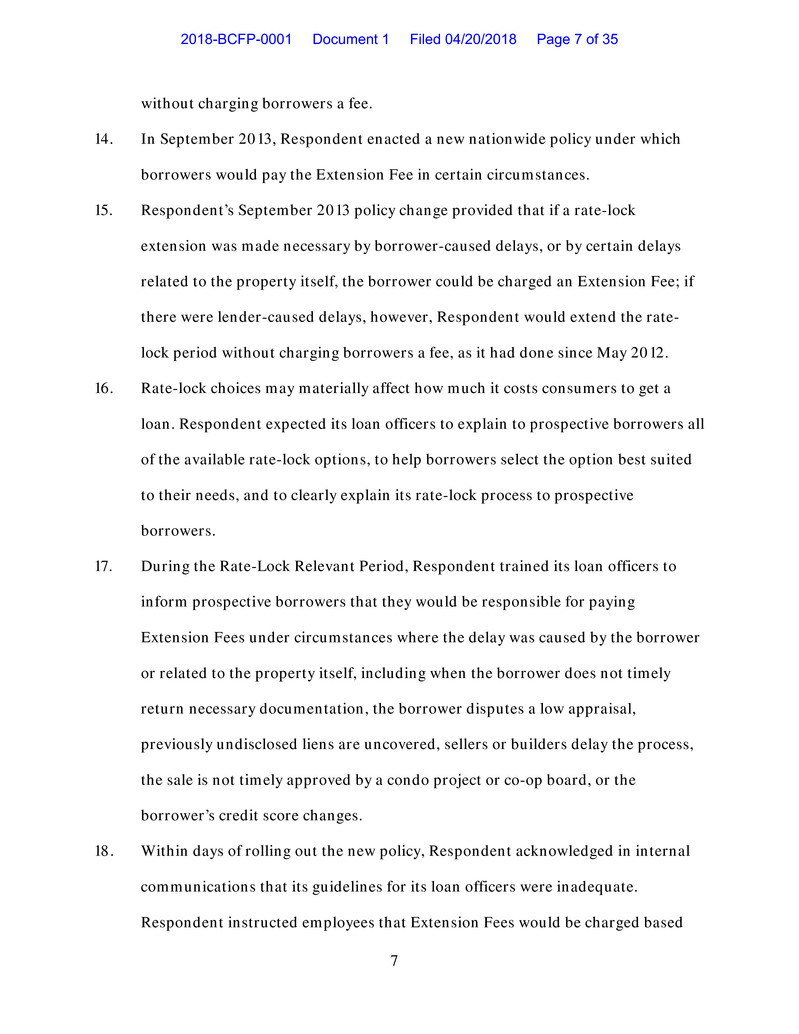
7 without charging borrowers a fee. 14. In September 2013, Respondent enacted a new nationwide policy under which borrowers would pay the Extension Fee in certain circumstances. 15. Respondent’s September 2013 policy change provided that if a rate-lock extension was made necessary by borrower-caused delays, or by certain delays related to the property itself, the borrower could be charged an Extension Fee; if there were lender-caused delays, however, Respondent would extend the rate- lock period without charging borrowers a fee, as it had done since May 2012. 16. Rate-lock choices may materially affect how much it costs consumers to get a loan. Respondent expected its loan officers to explain to prospective borrowers all of the available rate-lock options, to help borrowers select the option best suited to their needs, and to clearly explain its rate-lock process to prospective borrowers. 17. During the Rate-Lock Relevant Period, Respondent trained its loan officers to inform prospective borrowers that they would be responsible for paying Extension Fees under circumstances where the delay was caused by the borrower or related to the property itself, including when the borrower does not timely return necessary documentation, the borrower disputes a low appraisal, previously undisclosed liens are uncovered, sellers or builders delay the process, the sale is not timely approved by a condo project or co-op board, or the borrower’s credit score changes. 18. Within days of rolling out the new policy, Respondent acknowledged in internal communications that its guidelines for its loan officers were inadequate. Respondent instructed employees that Extension Fees would be charged based 2018-BCFP-0001 Document 1 Filed 04/20/2018 Page 7 of 35
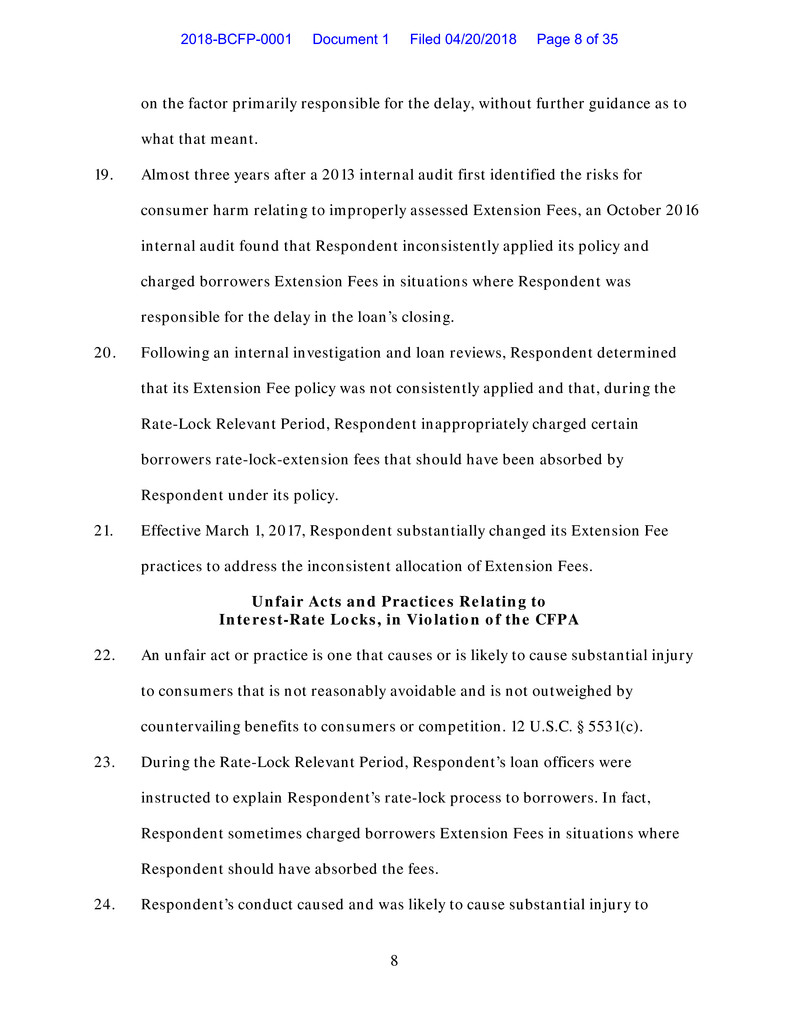
8 on the factor primarily responsible for the delay, without further guidance as to what that meant. 19. Almost three years after a 2013 internal audit first identified the risks for consumer harm relating to improperly assessed Extension Fees, an October 2016 internal audit found that Respondent inconsistently applied its policy and charged borrowers Extension Fees in situations where Respondent was responsible for the delay in the loan’s closing. 20. Following an internal investigation and loan reviews, Respondent determined that its Extension Fee policy was not consistently applied and that, during the Rate-Lock Relevant Period, Respondent inappropriately charged certain borrowers rate-lock-extension fees that should have been absorbed by Respondent under its policy. 21. Effective March 1, 2017, Respondent substantially changed its Extension Fee practices to address the inconsistent allocation of Extension Fees. Unfair Acts and Practices Relating to Interest-Rate Locks, in Violation of the CFPA 22. An unfair act or practice is one that causes or is likely to cause substantial injury to consumers that is not reasonably avoidable and is not outweighed by countervailing benefits to consumers or competition. 12 U.S.C. § 5531(c). 23. During the Rate-Lock Relevant Period, Respondent’s loan officers were instructed to explain Respondent’s rate-lock process to borrowers. In fact, Respondent sometimes charged borrowers Extension Fees in situations where Respondent should have absorbed the fees. 24. Respondent’s conduct caused and was likely to cause substantial injury to 2018-BCFP-0001 Document 1 Filed 04/20/2018 Page 8 of 35
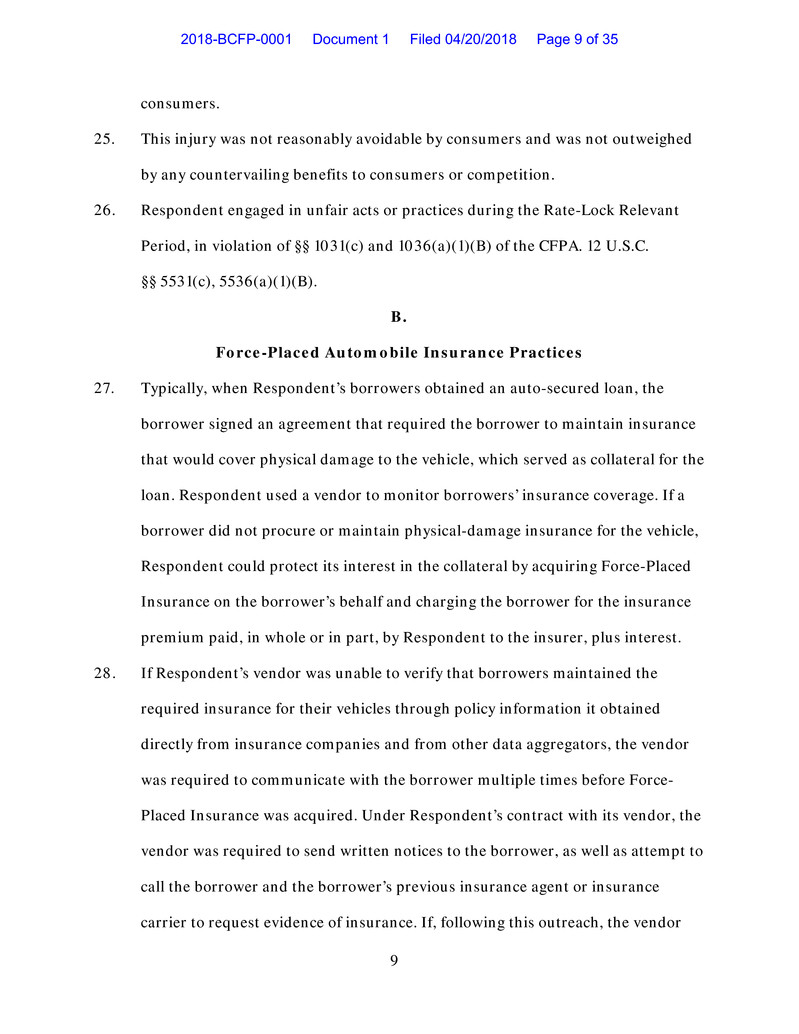
9 consumers. 25. This injury was not reasonably avoidable by consumers and was not outweighed by any countervailing benefits to consumers or competition. 26. Respondent engaged in unfair acts or practices during the Rate-Lock Relevant Period, in violation of §§ 1031(c) and 1036(a)(1)(B) of the CFPA. 12 U.S.C. §§ 5531(c), 5536(a)(1)(B). B. Force-Placed Automobile Insurance Practices 27. Typically, when Respondent’s borrowers obtained an auto-secured loan, the borrower signed an agreement that required the borrower to maintain insurance that would cover physical damage to the vehicle, which served as collateral for the loan. Respondent used a vendor to monitor borrowers’ insurance coverage. If a borrower did not procure or maintain physical-damage insurance for the vehicle, Respondent could protect its interest in the collateral by acquiring Force-Placed Insurance on the borrower’s behalf and charging the borrower for the insurance premium paid, in whole or in part, by Respondent to the insurer, plus interest. 28. If Respondent’s vendor was unable to verify that borrowers maintained the required insurance for their vehicles through policy information it obtained directly from insurance companies and from other data aggregators, the vendor was required to communicate with the borrower multiple times before Force- Placed Insurance was acquired. Under Respondent’s contract with its vendor, the vendor was required to send written notices to the borrower, as well as attempt to call the borrower and the borrower’s previous insurance agent or insurance carrier to request evidence of insurance. If, following this outreach, the vendor 2018-BCFP-0001 Document 1 Filed 04/20/2018 Page 9 of 35
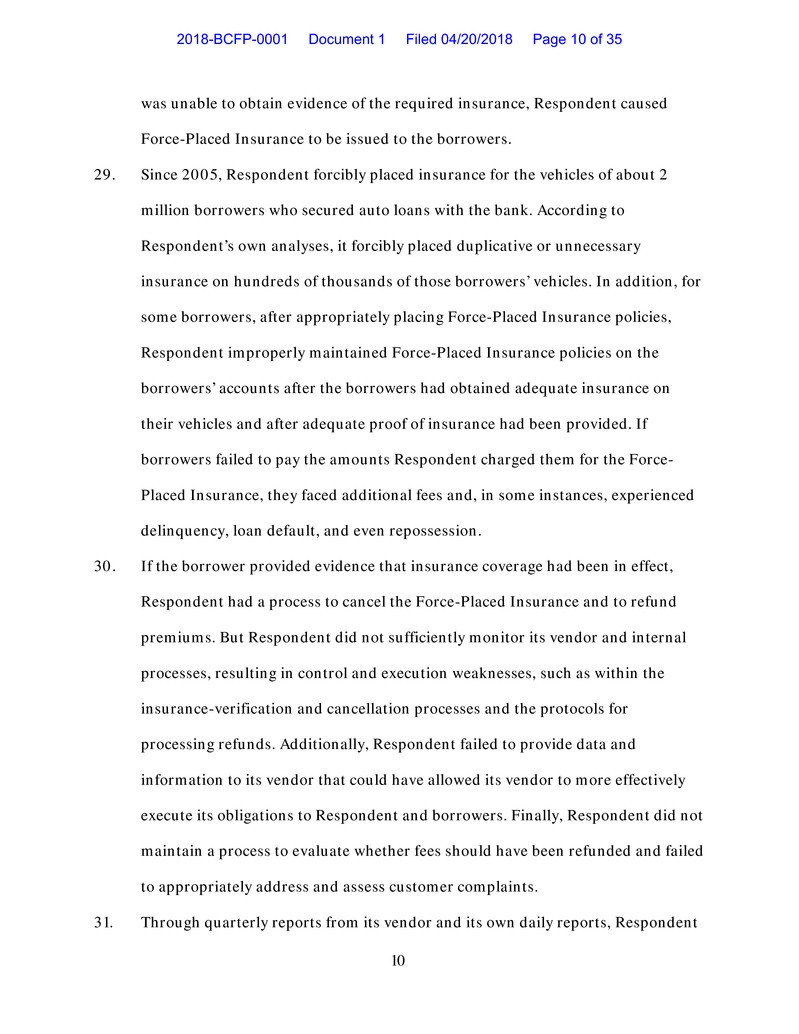
10 was unable to obtain evidence of the required insurance, Respondent caused Force-Placed Insurance to be issued to the borrowers. 29. Since 2005, Respondent forcibly placed insurance for the vehicles of about 2 million borrowers who secured auto loans with the bank. According to Respondent’s own analyses, it forcibly placed duplicative or unnecessary insurance on hundreds of thousands of those borrowers’ vehicles. In addition, for some borrowers, after appropriately placing Force-Placed Insurance policies, Respondent improperly maintained Force-Placed Insurance policies on the borrowers’ accounts after the borrowers had obtained adequate insurance on their vehicles and after adequate proof of insurance had been provided. If borrowers failed to pay the amounts Respondent charged them for the Force- Placed Insurance, they faced additional fees and, in some instances, experienced delinquency, loan default, and even repossession. 30. If the borrower provided evidence that insurance coverage had been in effect, Respondent had a process to cancel the Force-Placed Insurance and to refund premiums. But Respondent did not sufficiently monitor its vendor and internal processes, resulting in control and execution weaknesses, such as within the insurance-verification and cancellation processes and the protocols for processing refunds. Additionally, Respondent failed to provide data and information to its vendor that could have allowed its vendor to more effectively execute its obligations to Respondent and borrowers. Finally, Respondent did not maintain a process to evaluate whether fees should have been refunded and failed to appropriately address and assess customer complaints. 31. Through quarterly reports from its vendor and its own daily reports, Respondent 2018-BCFP-0001 Document 1 Filed 04/20/2018 Page 10 of 35
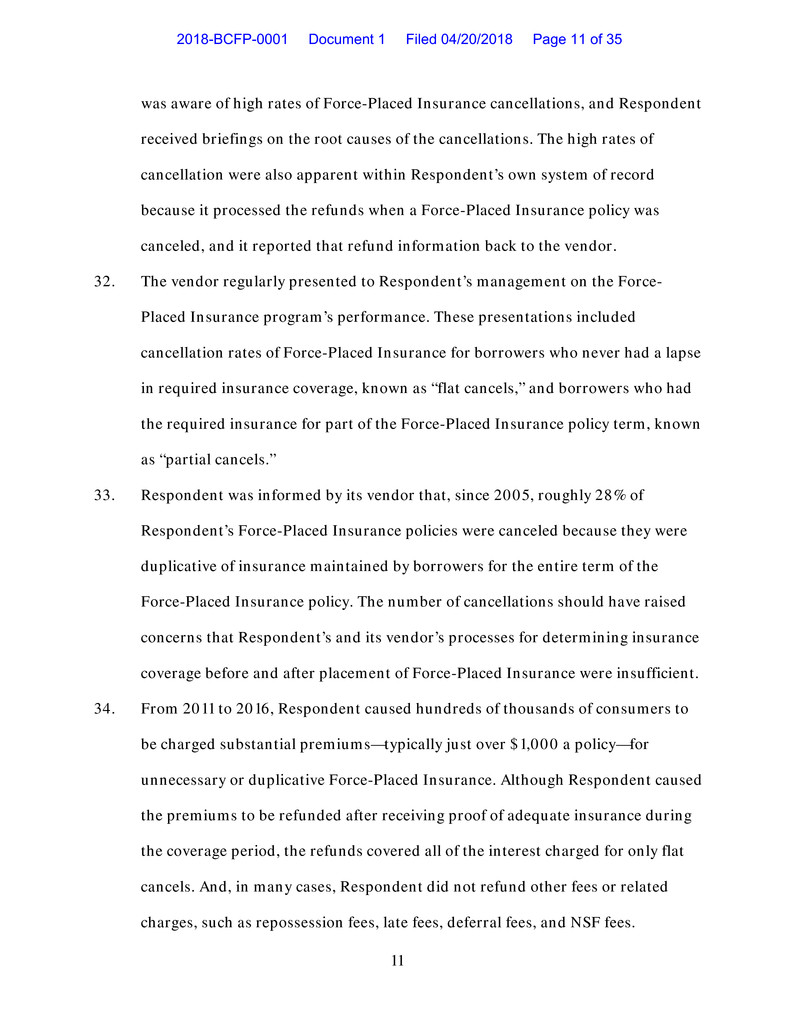
11 was aware of high rates of Force-Placed Insurance cancellations, and Respondent received briefings on the root causes of the cancellations. The high rates of cancellation were also apparent within Respondent’s own system of record because it processed the refunds when a Force-Placed Insurance policy was canceled, and it reported that refund information back to the vendor. 32. The vendor regularly presented to Respondent’s management on the Force- Placed Insurance program’s performance. These presentations included cancellation rates of Force-Placed Insurance for borrowers who never had a lapse in required insurance coverage, known as “flat cancels,” and borrowers who had the required insurance for part of the Force-Placed Insurance policy term, known as “partial cancels.” 33. Respondent was informed by its vendor that, since 2005, roughly 28% of Respondent’s Force-Placed Insurance policies were canceled because they were duplicative of insurance maintained by borrowers for the entire term of the Force-Placed Insurance policy. The number of cancellations should have raised concerns that Respondent’s and its vendor’s processes for determining insurance coverage before and after placement of Force-Placed Insurance were insufficient. 34. From 2011 to 2016, Respondent caused hundreds of thousands of consumers to be charged substantial premiums—typically just over $1,000 a policy—for unnecessary or duplicative Force-Placed Insurance. Although Respondent caused the premiums to be refunded after receiving proof of adequate insurance during the coverage period, the refunds covered all of the interest charged for only flat cancels. And, in many cases, Respondent did not refund other fees or related charges, such as repossession fees, late fees, deferral fees, and NSF fees. 2018-BCFP-0001 Document 1 Filed 04/20/2018 Page 11 of 35
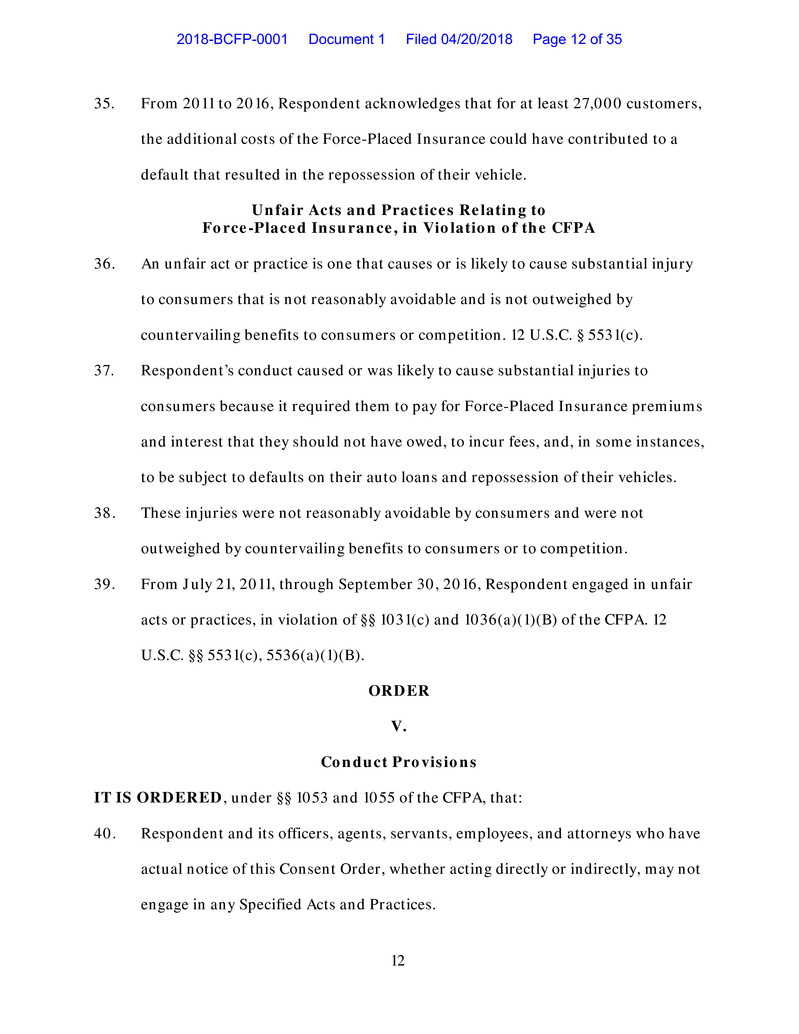
12 35. From 2011 to 2016, Respondent acknowledges that for at least 27,000 customers, the additional costs of the Force-Placed Insurance could have contributed to a default that resulted in the repossession of their vehicle. Unfair Acts and Practices Relating to Force-Placed Insurance, in Violation of the CFPA 36. An unfair act or practice is one that causes or is likely to cause substantial injury to consumers that is not reasonably avoidable and is not outweighed by countervailing benefits to consumers or competition. 12 U.S.C. § 5531(c). 37. Respondent’s conduct caused or was likely to cause substantial injuries to consumers because it required them to pay for Force-Placed Insurance premiums and interest that they should not have owed, to incur fees, and, in some instances, to be subject to defaults on their auto loans and repossession of their vehicles. 38. These injuries were not reasonably avoidable by consumers and were not outweighed by countervailing benefits to consumers or to competition. 39. From July 21, 2011, through September 30, 2016, Respondent engaged in unfair acts or practices, in violation of §§ 1031(c) and 1036(a)(1)(B) of the CFPA. 12 U.S.C. §§ 5531(c), 5536(a)(1)(B). ORDER V. Conduct Provisions IT IS ORDERED, under §§ 1053 and 1055 of the CFPA, that: 40. Respondent and its officers, agents, servants, employees, and attorneys who have actual notice of this Consent Order, whether acting directly or indirectly, may not engage in any Specified Acts and Practices. 2018-BCFP-0001 Document 1 Filed 04/20/2018 Page 12 of 35
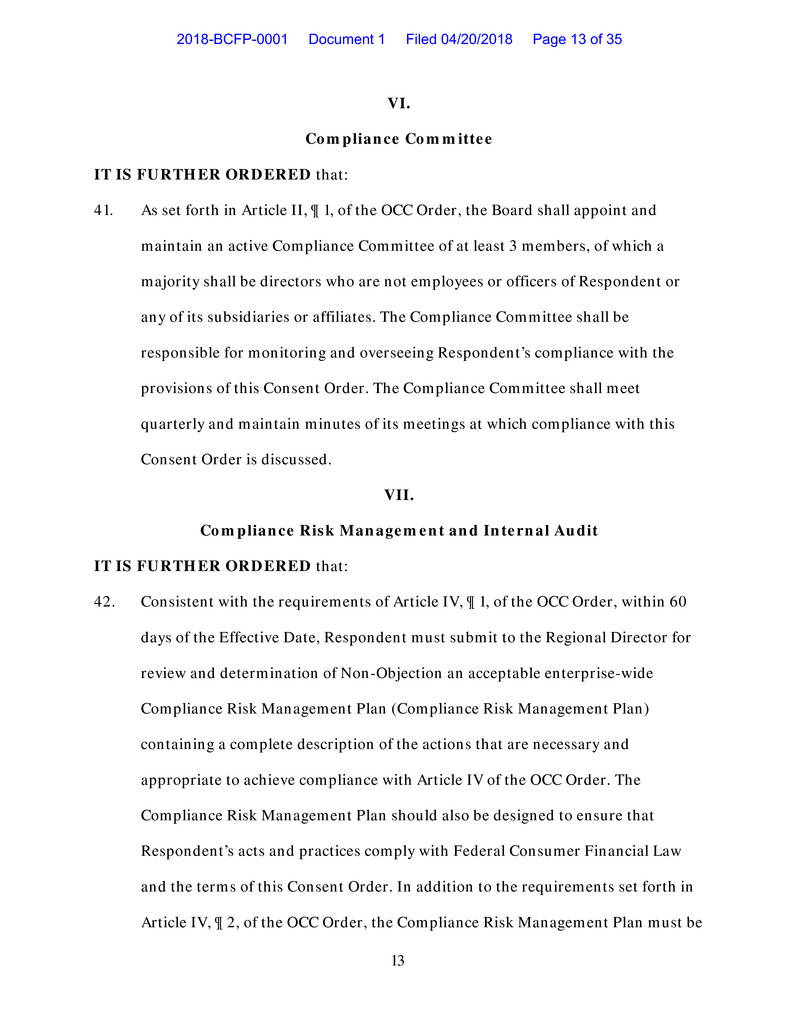
13 VI. Compliance Committee IT IS FURTHER ORDERED that: 41. As set forth in Article II, ¶ 1, of the OCC Order, the Board shall appoint and maintain an active Compliance Committee of at least 3 members, of which a majority shall be directors who are not employees or officers of Respondent or any of its subsidiaries or affiliates. The Compliance Committee shall be responsible for monitoring and overseeing Respondent’s compliance with the provisions of this Consent Order. The Compliance Committee shall meet quarterly and maintain minutes of its meetings at which compliance with this Consent Order is discussed. VII. Compliance Risk Management and Internal Audit IT IS FURTHER ORDERED that: 42. Consistent with the requirements of Article IV, ¶ 1, of the OCC Order, within 60 days of the Effective Date, Respondent must submit to the Regional Director for review and determination of Non-Objection an acceptable enterprise-wide Compliance Risk Management Plan (Compliance Risk Management Plan) containing a complete description of the actions that are necessary and appropriate to achieve compliance with Article IV of the OCC Order. The Compliance Risk Management Plan should also be designed to ensure that Respondent’s acts and practices comply with Federal Consumer Financial Law and the terms of this Consent Order. In addition to the requirements set forth in Article IV, ¶ 2, of the OCC Order, the Compliance Risk Management Plan must be 2018-BCFP-0001 Document 1 Filed 04/20/2018 Page 13 of 35
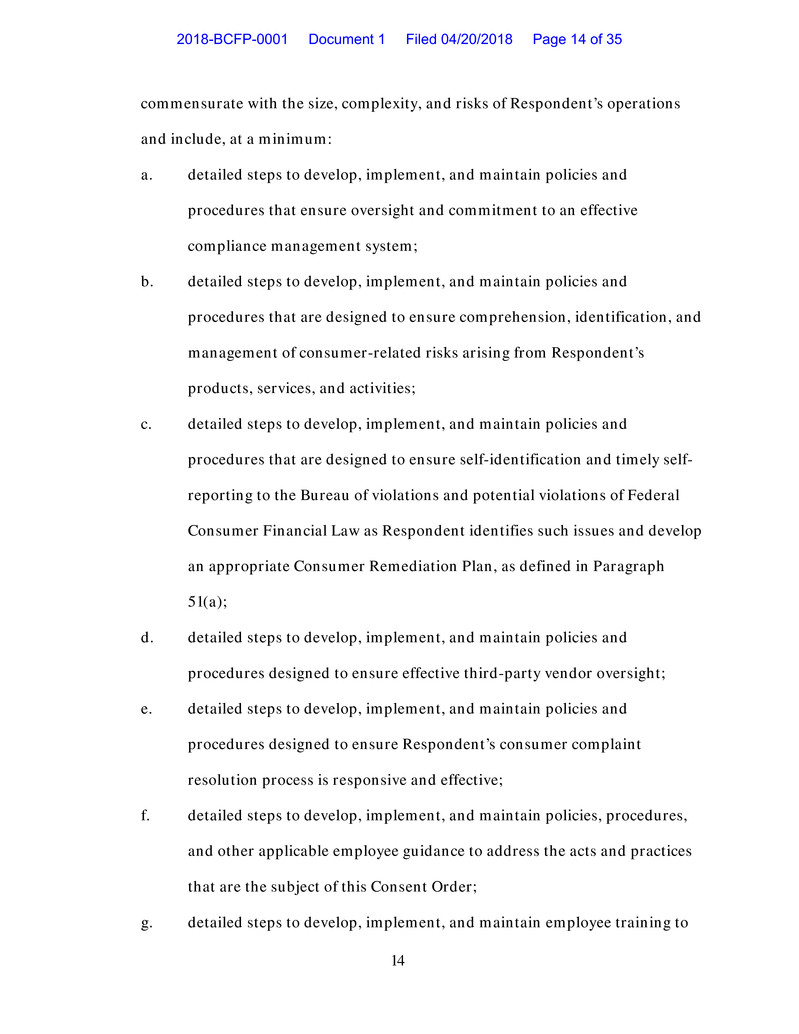
14 commensurate with the size, complexity, and risks of Respondent’s operations and include, at a minimum: a. detailed steps to develop, implement, and maintain policies and procedures that ensure oversight and commitment to an effective compliance management system; b. detailed steps to develop, implement, and maintain policies and procedures that are designed to ensure comprehension, identification, and management of consumer-related risks arising from Respondent’s products, services, and activities; c. detailed steps to develop, implement, and maintain policies and procedures that are designed to ensure self-identification and timely self- reporting to the Bureau of violations and potential violations of Federal Consumer Financial Law as Respondent identifies such issues and develop an appropriate Consumer Remediation Plan, as defined in Paragraph 51(a); d. detailed steps to develop, implement, and maintain policies and procedures designed to ensure effective third-party vendor oversight; e. detailed steps to develop, implement, and maintain policies and procedures designed to ensure Respondent’s consumer complaint resolution process is responsive and effective; f. detailed steps to develop, implement, and maintain policies, procedures, and other applicable employee guidance to address the acts and practices that are the subject of this Consent Order; g. detailed steps to develop, implement, and maintain employee training to 2018-BCFP-0001 Document 1 Filed 04/20/2018 Page 14 of 35
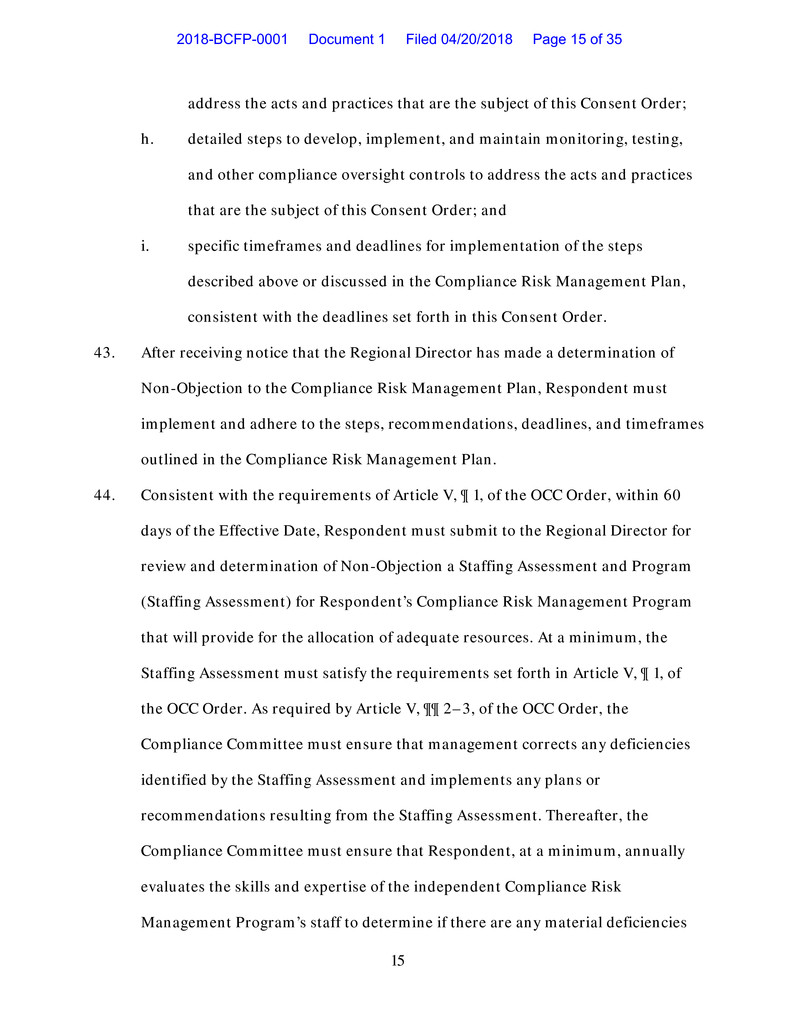
15 address the acts and practices that are the subject of this Consent Order; h. detailed steps to develop, implement, and maintain monitoring, testing, and other compliance oversight controls to address the acts and practices that are the subject of this Consent Order; and i. specific timeframes and deadlines for implementation of the steps described above or discussed in the Compliance Risk Management Plan, consistent with the deadlines set forth in this Consent Order. 43. After receiving notice that the Regional Director has made a determination of Non-Objection to the Compliance Risk Management Plan, Respondent must implement and adhere to the steps, recommendations, deadlines, and timeframes outlined in the Compliance Risk Management Plan. 44. Consistent with the requirements of Article V, ¶ 1, of the OCC Order, within 60 days of the Effective Date, Respondent must submit to the Regional Director for review and determination of Non-Objection a Staffing Assessment and Program (Staffing Assessment) for Respondent’s Compliance Risk Management Program that will provide for the allocation of adequate resources. At a minimum, the Staffing Assessment must satisfy the requirements set forth in Article V, ¶ 1, of the OCC Order. As required by Article V, ¶¶ 2–3, of the OCC Order, the Compliance Committee must ensure that management corrects any deficiencies identified by the Staffing Assessment and implements any plans or recommendations resulting from the Staffing Assessment. Thereafter, the Compliance Committee must ensure that Respondent, at a minimum, annually evaluates the skills and expertise of the independent Compliance Risk Management Program’s staff to determine if there are any material deficiencies 2018-BCFP-0001 Document 1 Filed 04/20/2018 Page 15 of 35
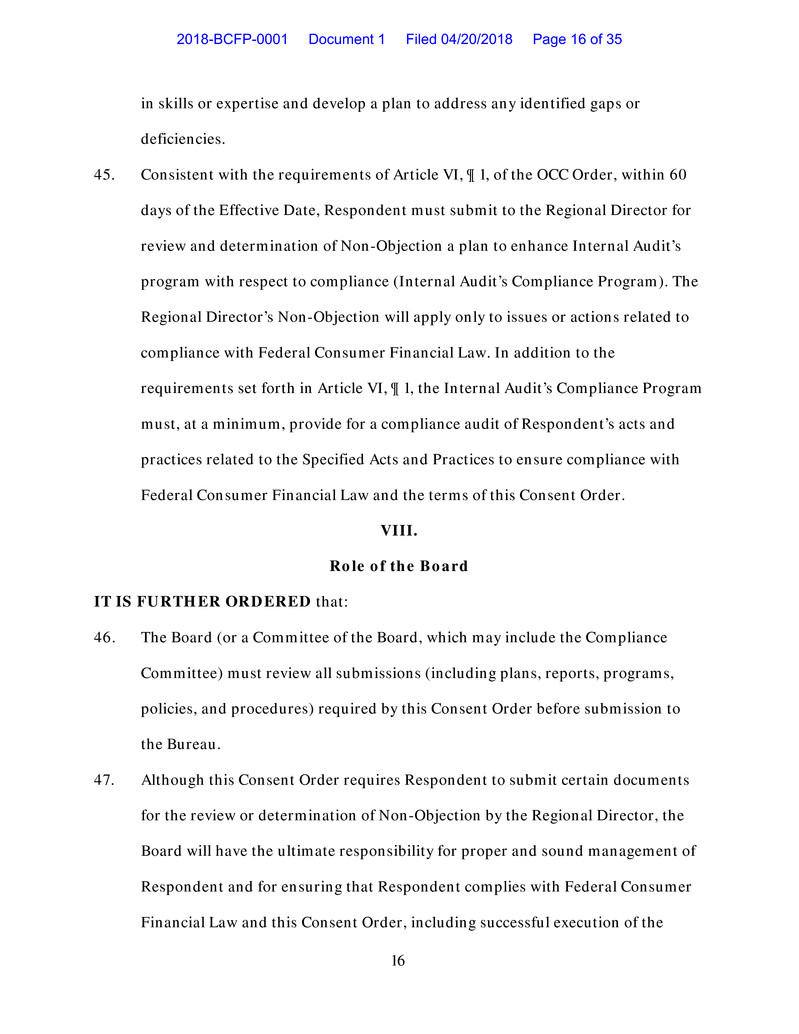
16 in skills or expertise and develop a plan to address any identified gaps or deficiencies. 45. Consistent with the requirements of Article VI, ¶ 1, of the OCC Order, within 60 days of the Effective Date, Respondent must submit to the Regional Director for review and determination of Non-Objection a plan to enhance Internal Audit’s program with respect to compliance (Internal Audit’s Compliance Program). The Regional Director’s Non-Objection will apply only to issues or actions related to compliance with Federal Consumer Financial Law. In addition to the requirements set forth in Article VI, ¶ 1, the Internal Audit’s Compliance Program must, at a minimum, provide for a compliance audit of Respondent’s acts and practices related to the Specified Acts and Practices to ensure compliance with Federal Consumer Financial Law and the terms of this Consent Order. VIII. Role of the Board IT IS FURTHER ORDERED that: 46. The Board (or a Committee of the Board, which may include the Compliance Committee) must review all submissions (including plans, reports, programs, policies, and procedures) required by this Consent Order before submission to the Bureau. 47. Although this Consent Order requires Respondent to submit certain documents for the review or determination of Non-Objection by the Regional Director, the Board will have the ultimate responsibility for proper and sound management of Respondent and for ensuring that Respondent complies with Federal Consumer Financial Law and this Consent Order, including successful execution of the 2018-BCFP-0001 Document 1 Filed 04/20/2018 Page 16 of 35
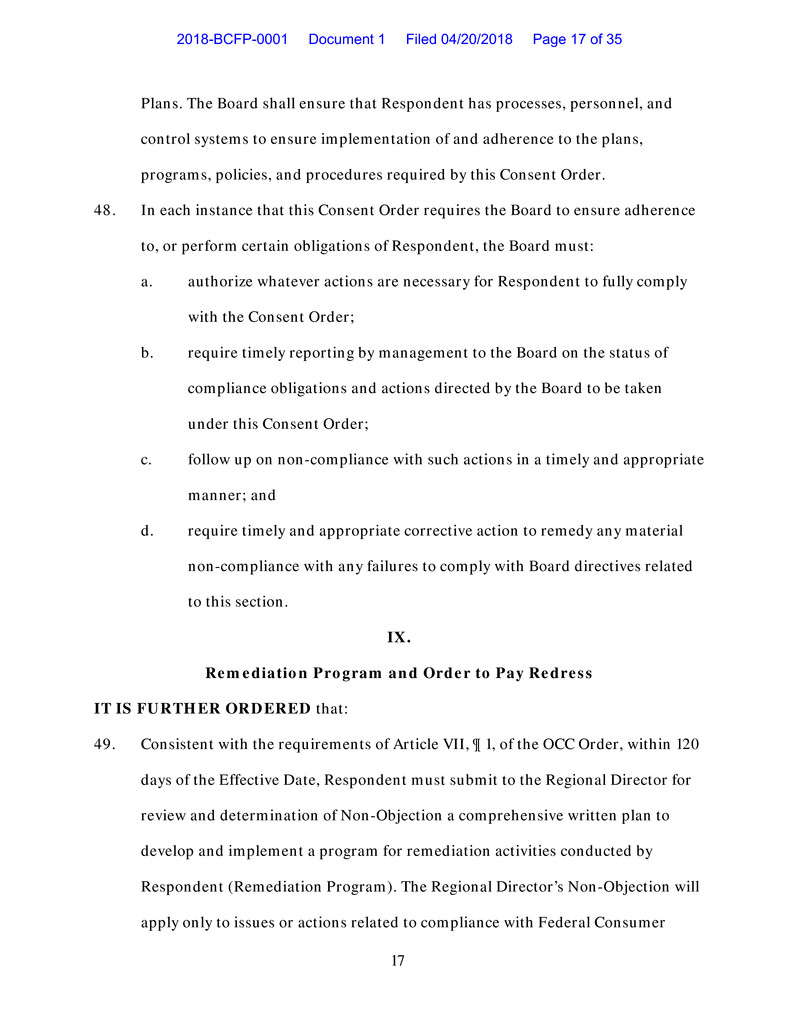
17 Plans. The Board shall ensure that Respondent has processes, personnel, and control systems to ensure implementation of and adherence to the plans, programs, policies, and procedures required by this Consent Order. 48. In each instance that this Consent Order requires the Board to ensure adherence to, or perform certain obligations of Respondent, the Board must: a. authorize whatever actions are necessary for Respondent to fully comply with the Consent Order; b. require timely reporting by management to the Board on the status of compliance obligations and actions directed by the Board to be taken under this Consent Order; c. follow up on non-compliance with such actions in a timely and appropriate manner; and d. require timely and appropriate corrective action to remedy any material non-compliance with any failures to comply with Board directives related to this section. IX. Remediation Program and Order to Pay Redress IT IS FURTHER ORDERED that: 49. Consistent with the requirements of Article VII, ¶ 1, of the OCC Order, within 120 days of the Effective Date, Respondent must submit to the Regional Director for review and determination of Non-Objection a comprehensive written plan to develop and implement a program for remediation activities conducted by Respondent (Remediation Program). The Regional Director’s Non-Objection will apply only to issues or actions related to compliance with Federal Consumer 2018-BCFP-0001 Document 1 Filed 04/20/2018 Page 17 of 35
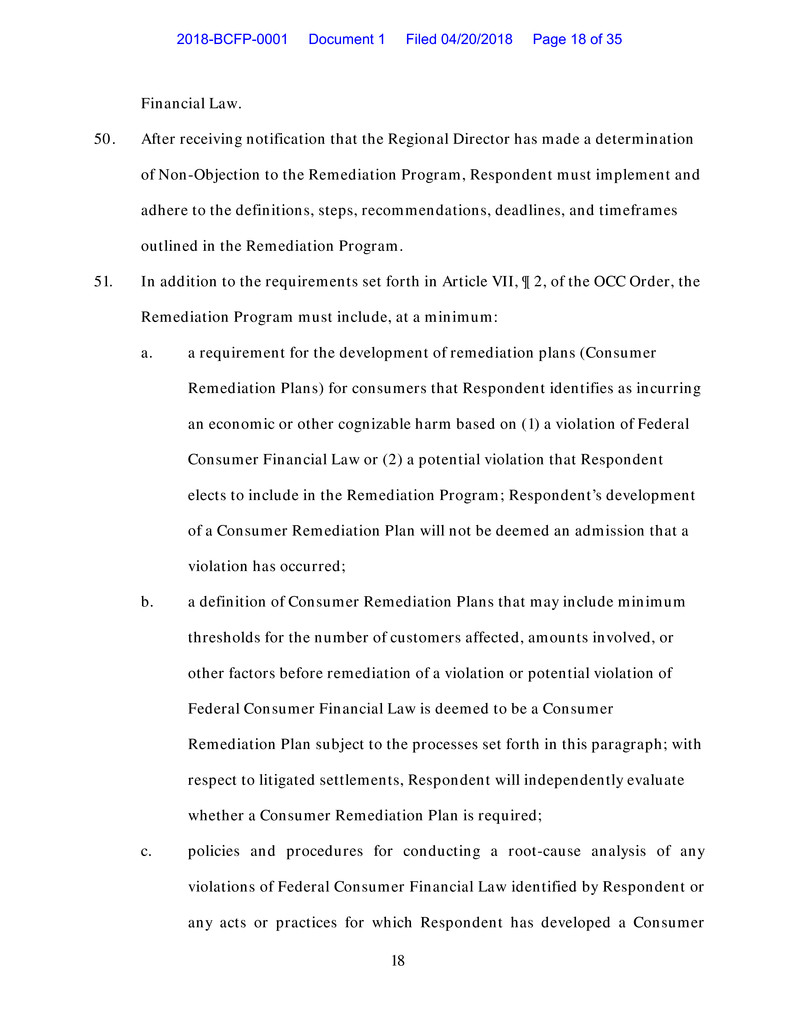
18 Financial Law. 50. After receiving notification that the Regional Director has made a determination of Non-Objection to the Remediation Program, Respondent must implement and adhere to the definitions, steps, recommendations, deadlines, and timeframes outlined in the Remediation Program. 51. In addition to the requirements set forth in Article VII, ¶ 2, of the OCC Order, the Remediation Program must include, at a minimum: a. a requirement for the development of remediation plans (Consumer Remediation Plans) for consumers that Respondent identifies as incurring an economic or other cognizable harm based on (1) a violation of Federal Consumer Financial Law or (2) a potential violation that Respondent elects to include in the Remediation Program; Respondent’s development of a Consumer Remediation Plan will not be deemed an admission that a violation has occurred; b. a definition of Consumer Remediation Plans that may include minimum thresholds for the number of customers affected, amounts involved, or other factors before remediation of a violation or potential violation of Federal Consumer Financial Law is deemed to be a Consumer Remediation Plan subject to the processes set forth in this paragraph; with respect to litigated settlements, Respondent will independently evaluate whether a Consumer Remediation Plan is required; c. policies and procedures for conducting a root-cause analysis of any violations of Federal Consumer Financial Law identified by Respondent or any acts or practices for which Respondent has developed a Consumer 2018-BCFP-0001 Document 1 Filed 04/20/2018 Page 18 of 35
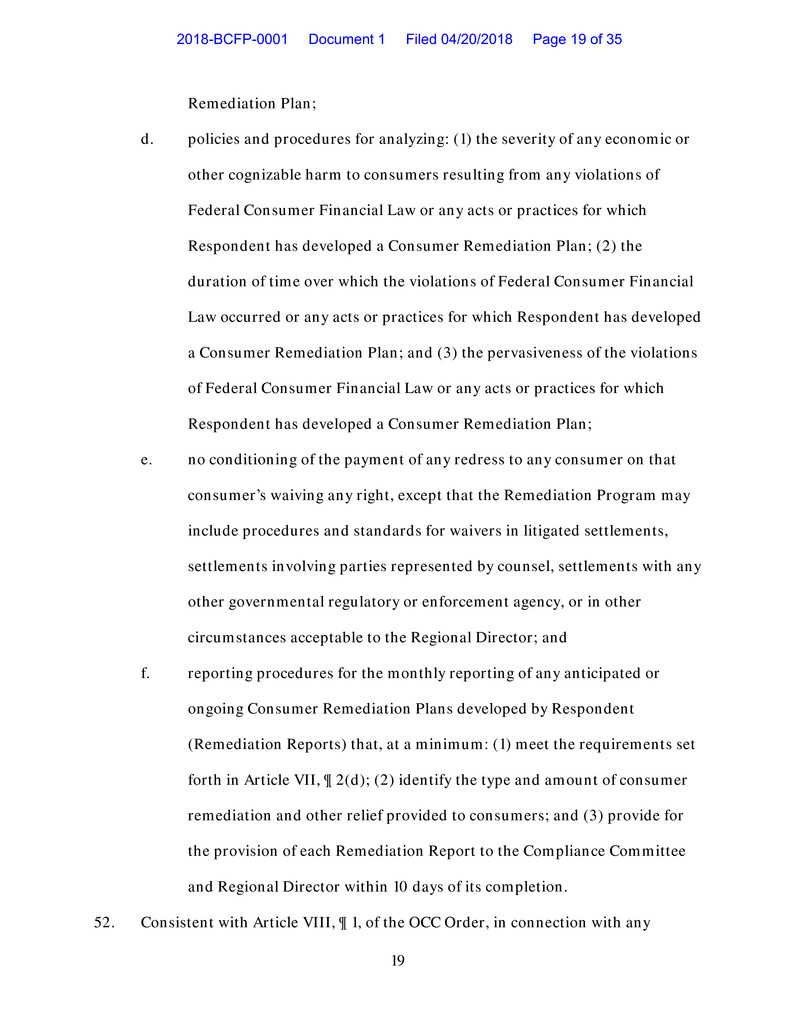
19 Remediation Plan; d. policies and procedures for analyzing: (1) the severity of any economic or other cognizable harm to consumers resulting from any violations of Federal Consumer Financial Law or any acts or practices for which Respondent has developed a Consumer Remediation Plan; (2) the duration of time over which the violations of Federal Consumer Financial Law occurred or any acts or practices for which Respondent has developed a Consumer Remediation Plan; and (3) the pervasiveness of the violations of Federal Consumer Financial Law or any acts or practices for which Respondent has developed a Consumer Remediation Plan; e. no conditioning of the payment of any redress to any consumer on that consumer’s waiving any right, except that the Remediation Program may include procedures and standards for waivers in litigated settlements, settlements involving parties represented by counsel, settlements with any other governmental regulatory or enforcement agency, or in other circumstances acceptable to the Regional Director; and f. reporting procedures for the monthly reporting of any anticipated or ongoing Consumer Remediation Plans developed by Respondent (Remediation Reports) that, at a minimum: (1) meet the requirements set forth in Article VII, ¶ 2(d); (2) identify the type and amount of consumer remediation and other relief provided to consumers; and (3) provide for the provision of each Remediation Report to the Compliance Committee and Regional Director within 10 days of its completion. 52. Consistent with Article VIII, ¶ 1, of the OCC Order, in connection with any 2018-BCFP-0001 Document 1 Filed 04/20/2018 Page 19 of 35
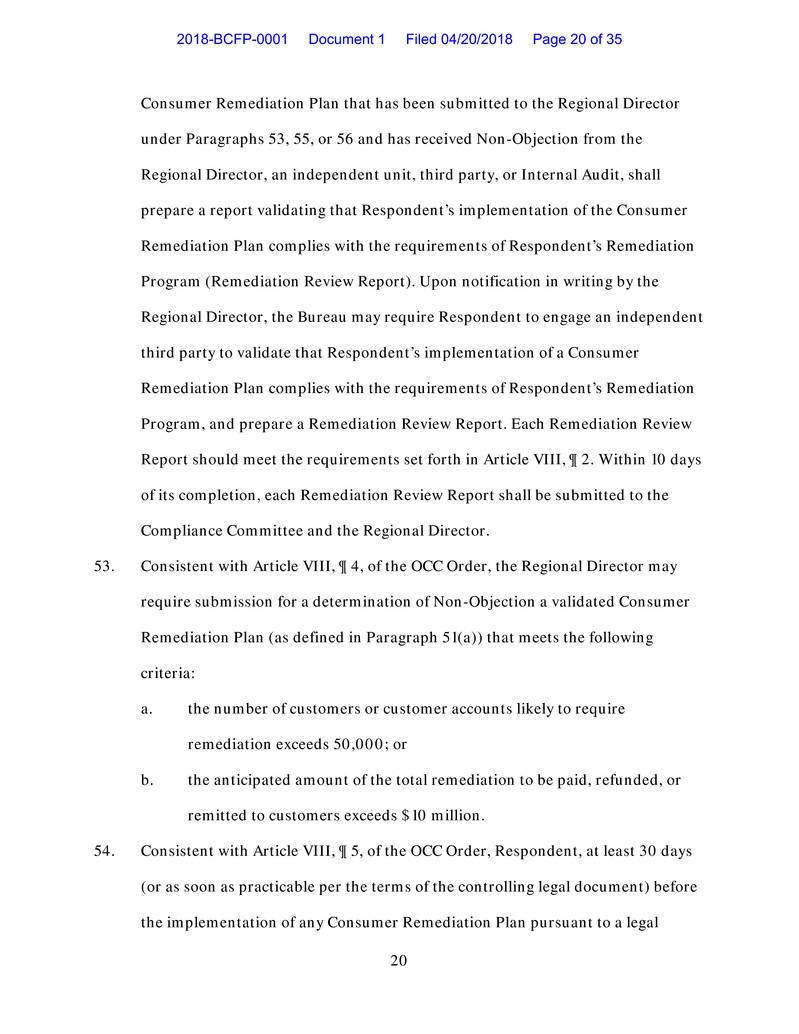
20 Consumer Remediation Plan that has been submitted to the Regional Director under Paragraphs 53, 55, or 56 and has received Non-Objection from the Regional Director, an independent unit, third party, or Internal Audit, shall prepare a report validating that Respondent’s implementation of the Consumer Remediation Plan complies with the requirements of Respondent’s Remediation Program (Remediation Review Report). Upon notification in writing by the Regional Director, the Bureau may require Respondent to engage an independent third party to validate that Respondent’s implementation of a Consumer Remediation Plan complies with the requirements of Respondent’s Remediation Program, and prepare a Remediation Review Report. Each Remediation Review Report should meet the requirements set forth in Article VIII, ¶ 2. Within 10 days of its completion, each Remediation Review Report shall be submitted to the Compliance Committee and the Regional Director. 53. Consistent with Article VIII, ¶ 4, of the OCC Order, the Regional Director may require submission for a determination of Non-Objection a validated Consumer Remediation Plan (as defined in Paragraph 51(a)) that meets the following criteria: a. the number of customers or customer accounts likely to require remediation exceeds 50,000; or b. the anticipated amount of the total remediation to be paid, refunded, or remitted to customers exceeds $10 million. 54. Consistent with Article VIII, ¶ 5, of the OCC Order, Respondent, at least 30 days (or as soon as practicable per the terms of the controlling legal document) before the implementation of any Consumer Remediation Plan pursuant to a legal 2018-BCFP-0001 Document 1 Filed 04/20/2018 Page 20 of 35
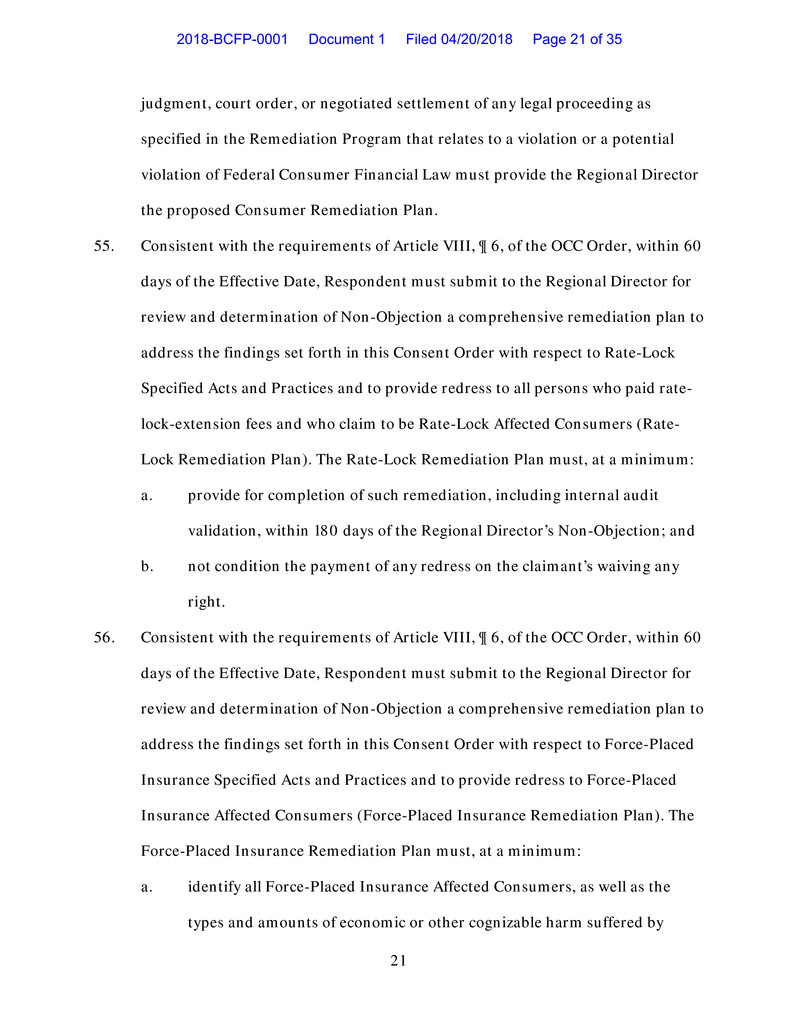
21 judgment, court order, or negotiated settlement of any legal proceeding as specified in the Remediation Program that relates to a violation or a potential violation of Federal Consumer Financial Law must provide the Regional Director the proposed Consumer Remediation Plan. 55. Consistent with the requirements of Article VIII, ¶ 6, of the OCC Order, within 60 days of the Effective Date, Respondent must submit to the Regional Director for review and determination of Non-Objection a comprehensive remediation plan to address the findings set forth in this Consent Order with respect to Rate-Lock Specified Acts and Practices and to provide redress to all persons who paid rate- lock-extension fees and who claim to be Rate-Lock Affected Consumers (Rate- Lock Remediation Plan). The Rate-Lock Remediation Plan must, at a minimum: a. provide for completion of such remediation, including internal audit validation, within 180 days of the Regional Director’s Non-Objection; and b. not condition the payment of any redress on the claimant’s waiving any right. 56. Consistent with the requirements of Article VIII, ¶ 6, of the OCC Order, within 60 days of the Effective Date, Respondent must submit to the Regional Director for review and determination of Non-Objection a comprehensive remediation plan to address the findings set forth in this Consent Order with respect to Force-Placed Insurance Specified Acts and Practices and to provide redress to Force-Placed Insurance Affected Consumers (Force-Placed Insurance Remediation Plan). The Force-Placed Insurance Remediation Plan must, at a minimum: a. identify all Force-Placed Insurance Affected Consumers, as well as the types and amounts of economic or other cognizable harm suffered by 2018-BCFP-0001 Document 1 Filed 04/20/2018 Page 21 of 35
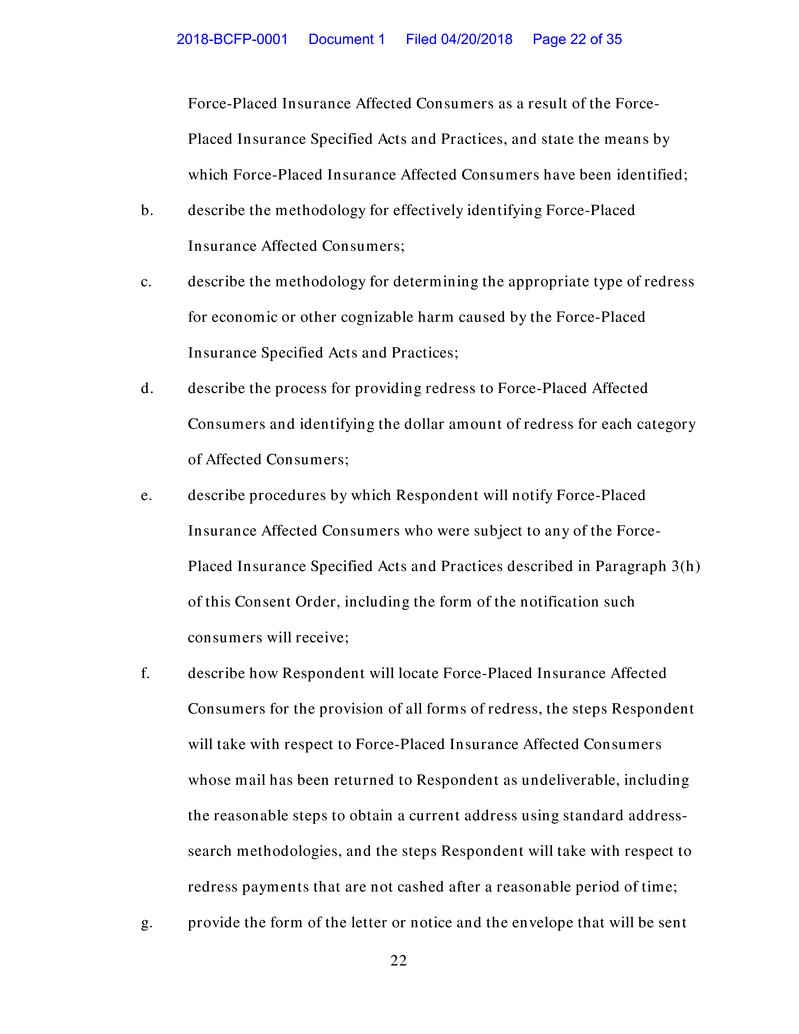
22 Force-Placed Insurance Affected Consumers as a result of the Force- Placed Insurance Specified Acts and Practices, and state the means by which Force-Placed Insurance Affected Consumers have been identified; b. describe the methodology for effectively identifying Force-Placed Insurance Affected Consumers; c. describe the methodology for determining the appropriate type of redress for economic or other cognizable harm caused by the Force-Placed Insurance Specified Acts and Practices; d. describe the process for providing redress to Force-Placed Affected Consumers and identifying the dollar amount of redress for each category of Affected Consumers; e. describe procedures by which Respondent will notify Force-Placed Insurance Affected Consumers who were subject to any of the Force- Placed Insurance Specified Acts and Practices described in Paragraph 3(h) of this Consent Order, including the form of the notification such consumers will receive; f. describe how Respondent will locate Force-Placed Insurance Affected Consumers for the provision of all forms of redress, the steps Respondent will take with respect to Force-Placed Insurance Affected Consumers whose mail has been returned to Respondent as undeliverable, including the reasonable steps to obtain a current address using standard address- search methodologies, and the steps Respondent will take with respect to redress payments that are not cashed after a reasonable period of time; g. provide the form of the letter or notice and the envelope that will be sent 2018-BCFP-0001 Document 1 Filed 04/20/2018 Page 22 of 35
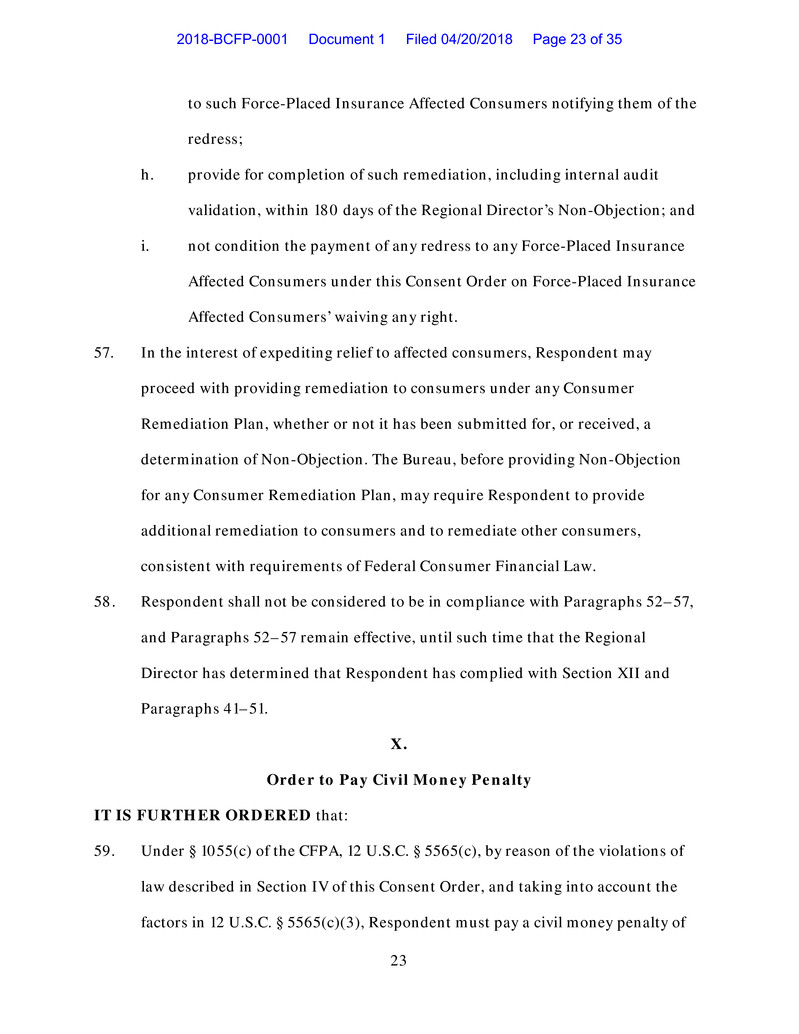
23 to such Force-Placed Insurance Affected Consumers notifying them of the redress; h. provide for completion of such remediation, including internal audit validation, within 180 days of the Regional Director’s Non-Objection; and i. not condition the payment of any redress to any Force-Placed Insurance Affected Consumers under this Consent Order on Force-Placed Insurance Affected Consumers’ waiving any right. 57. In the interest of expediting relief to affected consumers, Respondent may proceed with providing remediation to consumers under any Consumer Remediation Plan, whether or not it has been submitted for, or received, a determination of Non-Objection. The Bureau, before providing Non-Objection for any Consumer Remediation Plan, may require Respondent to provide additional remediation to consumers and to remediate other consumers, consistent with requirements of Federal Consumer Financial Law. 58. Respondent shall not be considered to be in compliance with Paragraphs 52–57, and Paragraphs 52–57 remain effective, until such time that the Regional Director has determined that Respondent has complied with Section XII and Paragraphs 41–51. X. Order to Pay Civil Money Penalty IT IS FURTHER ORDERED that: 59. Under § 1055(c) of the CFPA, 12 U.S.C. § 5565(c), by reason of the violations of law described in Section IV of this Consent Order, and taking into account the factors in 12 U.S.C. § 5565(c)(3), Respondent must pay a civil money penalty of 2018-BCFP-0001 Document 1 Filed 04/20/2018 Page 23 of 35
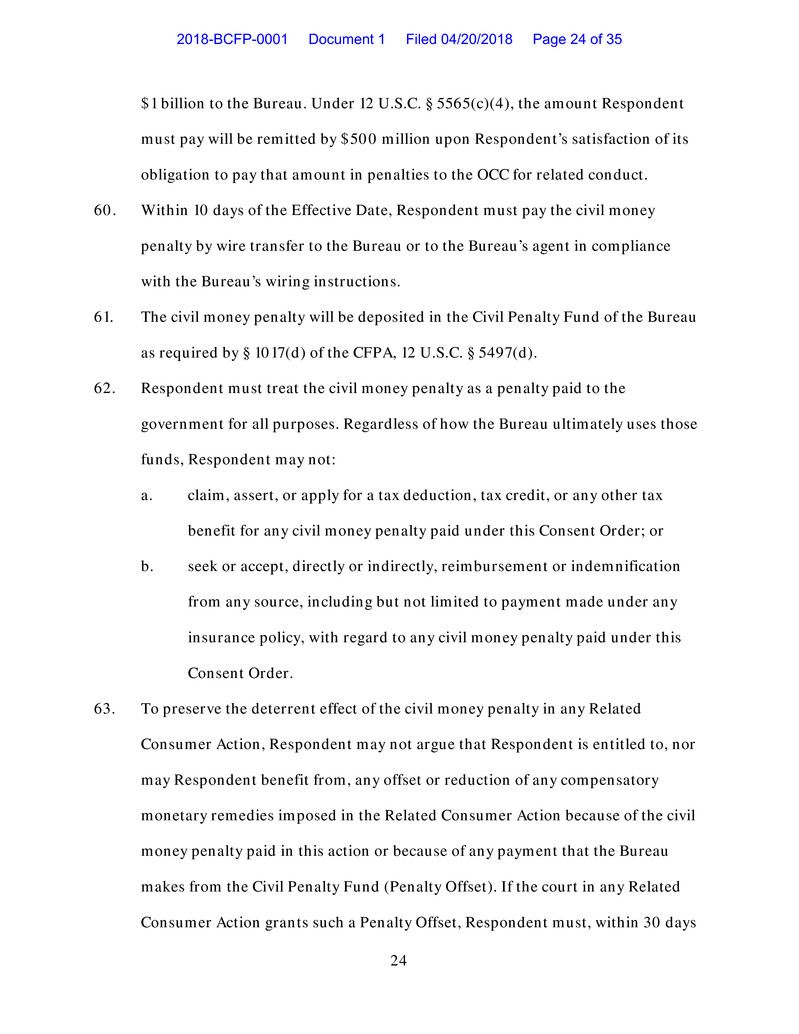
24 $1 billion to the Bureau. Under 12 U.S.C. § 5565(c)(4), the amount Respondent must pay will be remitted by $500 million upon Respondent’s satisfaction of its obligation to pay that amount in penalties to the OCC for related conduct. 60. Within 10 days of the Effective Date, Respondent must pay the civil money penalty by wire transfer to the Bureau or to the Bureau’s agent in compliance with the Bureau’s wiring instructions. 61. The civil money penalty will be deposited in the Civil Penalty Fund of the Bureau as required by § 1017(d) of the CFPA, 12 U.S.C. § 5497(d). 62. Respondent must treat the civil money penalty as a penalty paid to the government for all purposes. Regardless of how the Bureau ultimately uses those funds, Respondent may not: a. claim, assert, or apply for a tax deduction, tax credit, or any other tax benefit for any civil money penalty paid under this Consent Order; or b. seek or accept, directly or indirectly, reimbursement or indemnification from any source, including but not limited to payment made under any insurance policy, with regard to any civil money penalty paid under this Consent Order. 63. To preserve the deterrent effect of the civil money penalty in any Related Consumer Action, Respondent may not argue that Respondent is entitled to, nor may Respondent benefit from, any offset or reduction of any compensatory monetary remedies imposed in the Related Consumer Action because of the civil money penalty paid in this action or because of any payment that the Bureau makes from the Civil Penalty Fund (Penalty Offset). If the court in any Related Consumer Action grants such a Penalty Offset, Respondent must, within 30 days 2018-BCFP-0001 Document 1 Filed 04/20/2018 Page 24 of 35
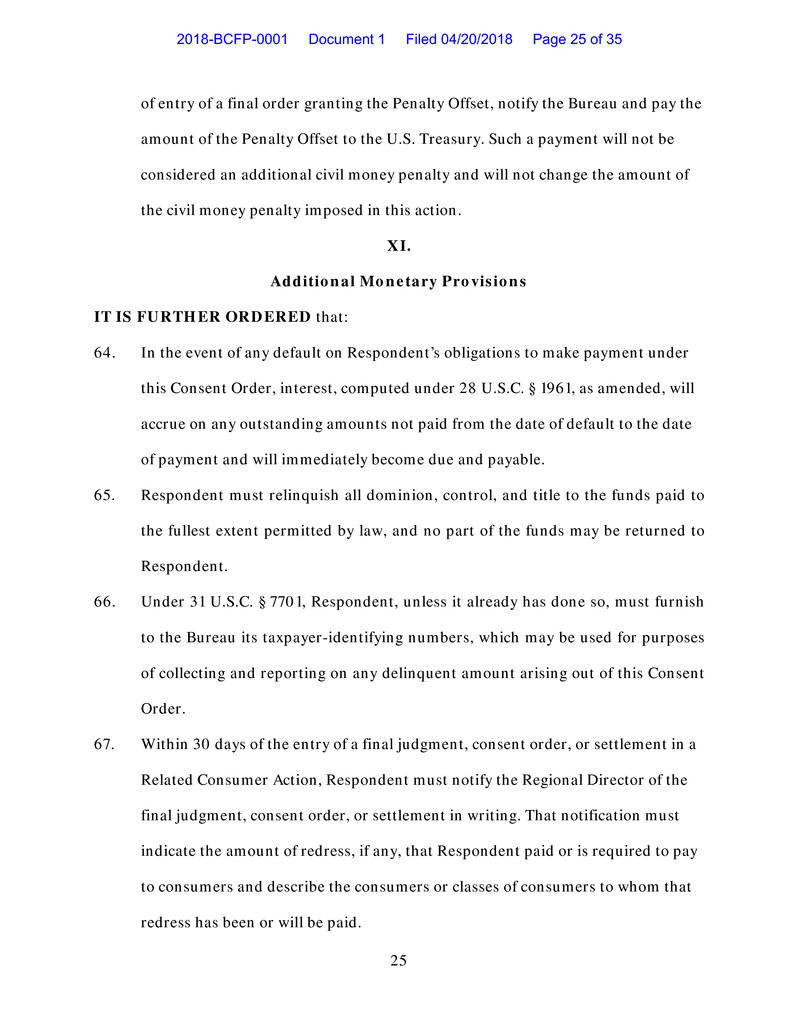
25 of entry of a final order granting the Penalty Offset, notify the Bureau and pay the amount of the Penalty Offset to the U.S. Treasury. Such a payment will not be considered an additional civil money penalty and will not change the amount of the civil money penalty imposed in this action. XI. Additional Monetary Provisions IT IS FURTHER ORDERED that: 64. In the event of any default on Respondent’s obligations to make payment under this Consent Order, interest, computed under 28 U.S.C. § 1961, as amended, will accrue on any outstanding amounts not paid from the date of default to the date of payment and will immediately become due and payable. 65. Respondent must relinquish all dominion, control, and title to the funds paid to the fullest extent permitted by law, and no part of the funds may be returned to Respondent. 66. Under 31 U.S.C. § 7701, Respondent, unless it already has done so, must furnish to the Bureau its taxpayer-identifying numbers, which may be used for purposes of collecting and reporting on any delinquent amount arising out of this Consent Order. 67. Within 30 days of the entry of a final judgment, consent order, or settlement in a Related Consumer Action, Respondent must notify the Regional Director of the final judgment, consent order, or settlement in writing. That notification must indicate the amount of redress, if any, that Respondent paid or is required to pay to consumers and describe the consumers or classes of consumers to whom that redress has been or will be paid. 2018-BCFP-0001 Document 1 Filed 04/20/2018 Page 25 of 35
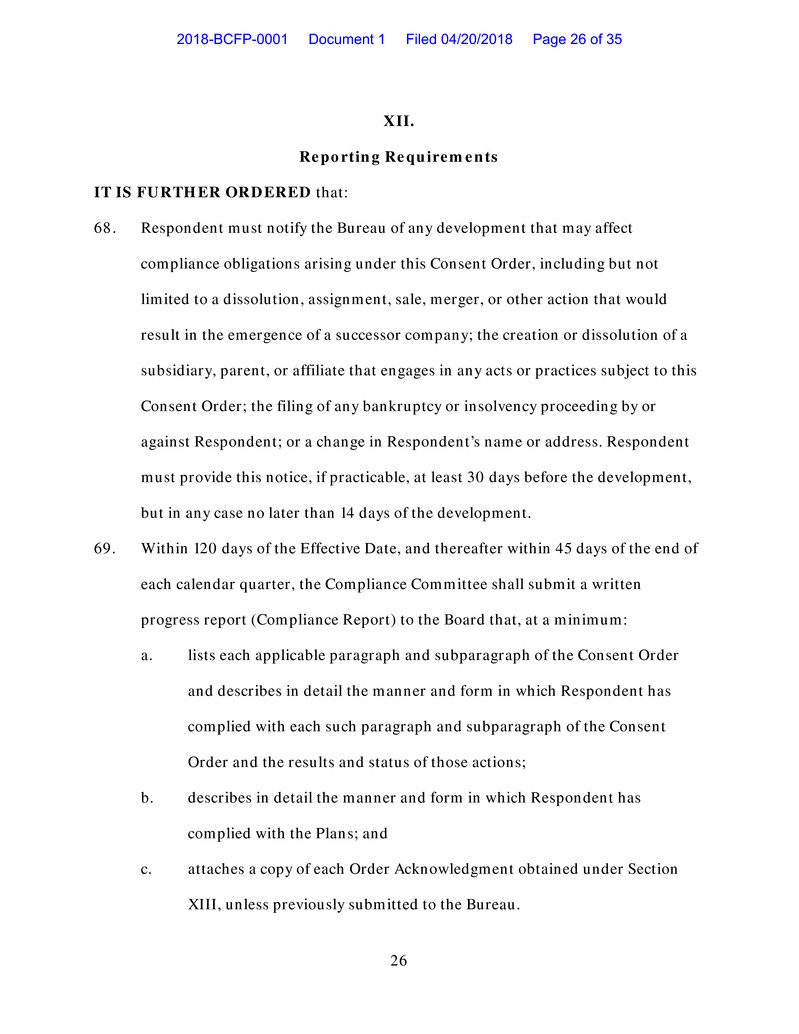
26 XII. Reporting Requirements IT IS FURTHER ORDERED that: 68. Respondent must notify the Bureau of any development that may affect compliance obligations arising under this Consent Order, including but not limited to a dissolution, assignment, sale, merger, or other action that would result in the emergence of a successor company; the creation or dissolution of a subsidiary, parent, or affiliate that engages in any acts or practices subject to this Consent Order; the filing of any bankruptcy or insolvency proceeding by or against Respondent; or a change in Respondent’s name or address. Respondent must provide this notice, if practicable, at least 30 days before the development, but in any case no later than 14 days of the development. 69. Within 120 days of the Effective Date, and thereafter within 45 days of the end of each calendar quarter, the Compliance Committee shall submit a written progress report (Compliance Report) to the Board that, at a minimum: a. lists each applicable paragraph and subparagraph of the Consent Order and describes in detail the manner and form in which Respondent has complied with each such paragraph and subparagraph of the Consent Order and the results and status of those actions; b. describes in detail the manner and form in which Respondent has complied with the Plans; and c. attaches a copy of each Order Acknowledgment obtained under Section XIII, unless previously submitted to the Bureau. 2018-BCFP-0001 Document 1 Filed 04/20/2018 Page 26 of 35
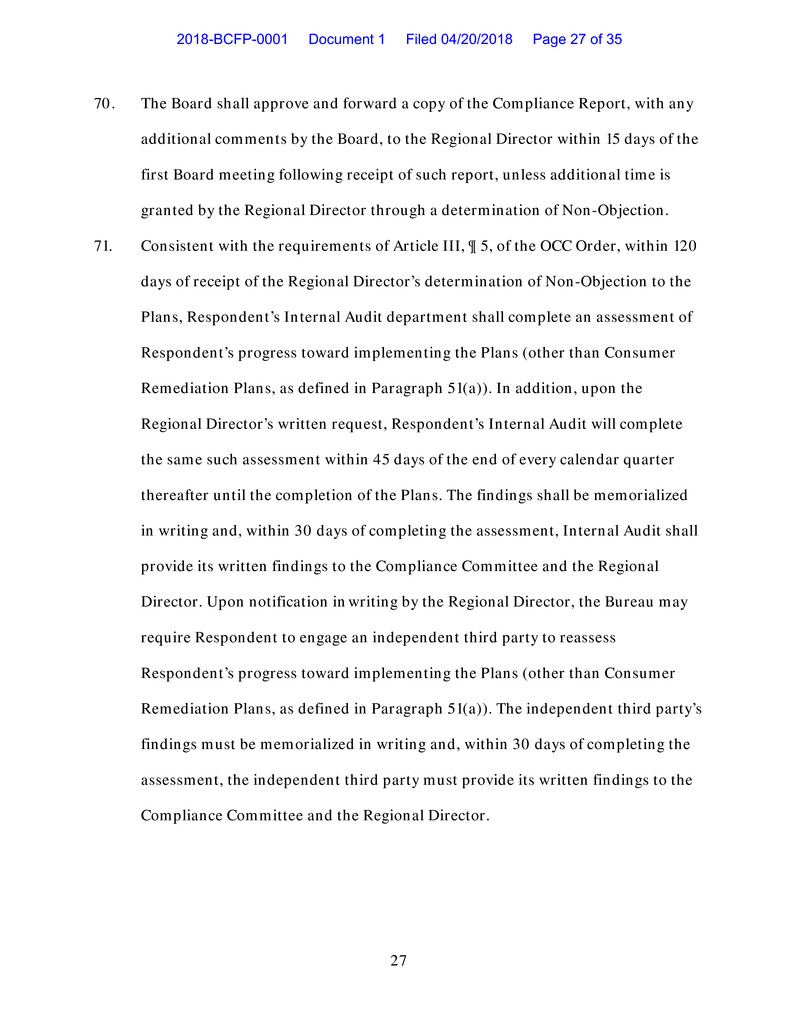
27 70. The Board shall approve and forward a copy of the Compliance Report, with any additional comments by the Board, to the Regional Director within 15 days of the first Board meeting following receipt of such report, unless additional time is granted by the Regional Director through a determination of Non-Objection. 71. Consistent with the requirements of Article III, ¶ 5, of the OCC Order, within 120 days of receipt of the Regional Director’s determination of Non-Objection to the Plans, Respondent’s Internal Audit department shall complete an assessment of Respondent’s progress toward implementing the Plans (other than Consumer Remediation Plans, as defined in Paragraph 51(a)). In addition, upon the Regional Director’s written request, Respondent’s Internal Audit will complete the same such assessment within 45 days of the end of every calendar quarter thereafter until the completion of the Plans. The findings shall be memorialized in writing and, within 30 days of completing the assessment, Internal Audit shall provide its written findings to the Compliance Committee and the Regional Director. Upon notification in writing by the Regional Director, the Bureau may require Respondent to engage an independent third party to reassess Respondent’s progress toward implementing the Plans (other than Consumer Remediation Plans, as defined in Paragraph 51(a)). The independent third party’s findings must be memorialized in writing and, within 30 days of completing the assessment, the independent third party must provide its written findings to the Compliance Committee and the Regional Director. 2018-BCFP-0001 Document 1 Filed 04/20/2018 Page 27 of 35
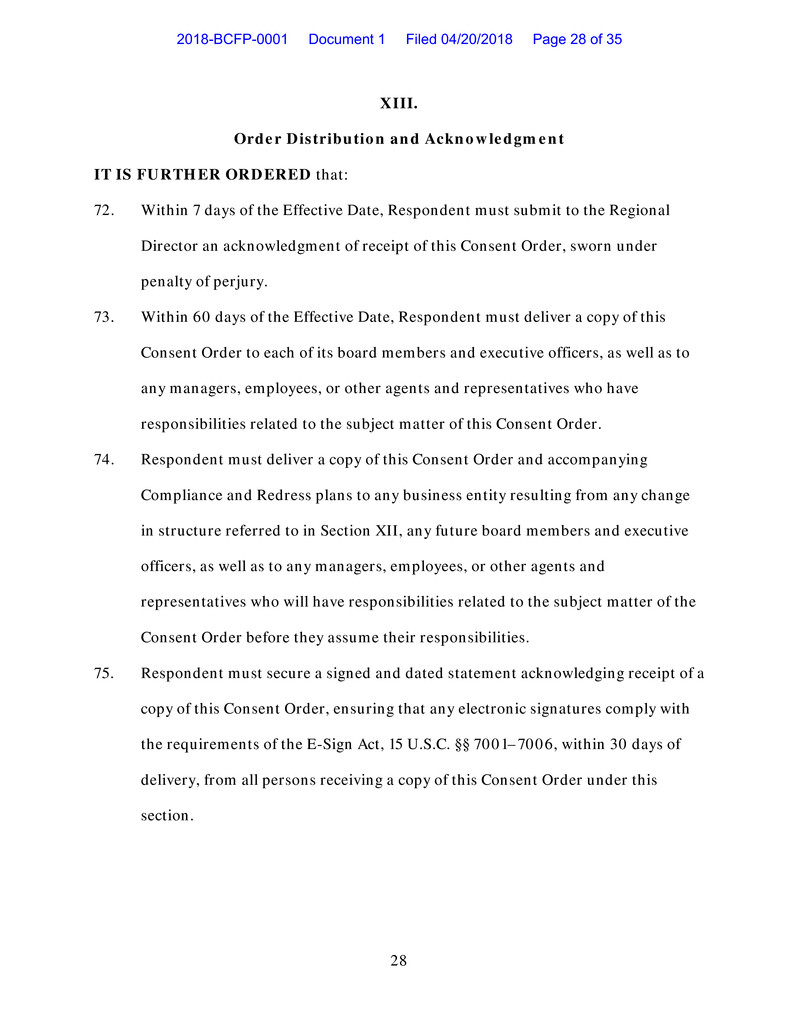
28 XIII. Order Distribution and Acknowledgment IT IS FURTHER ORDERED that: 72. Within 7 days of the Effective Date, Respondent must submit to the Regional Director an acknowledgment of receipt of this Consent Order, sworn under penalty of perjury. 73. Within 60 days of the Effective Date, Respondent must deliver a copy of this Consent Order to each of its board members and executive officers, as well as to any managers, employees, or other agents and representatives who have responsibilities related to the subject matter of this Consent Order. 74. Respondent must deliver a copy of this Consent Order and accompanying Compliance and Redress plans to any business entity resulting from any change in structure referred to in Section XII, any future board members and executive officers, as well as to any managers, employees, or other agents and representatives who will have responsibilities related to the subject matter of the Consent Order before they assume their responsibilities. 75. Respondent must secure a signed and dated statement acknowledging receipt of a copy of this Consent Order, ensuring that any electronic signatures comply with the requirements of the E-Sign Act, 15 U.S.C. §§ 7001–7006, within 30 days of delivery, from all persons receiving a copy of this Consent Order under this section. 2018-BCFP-0001 Document 1 Filed 04/20/2018 Page 28 of 35
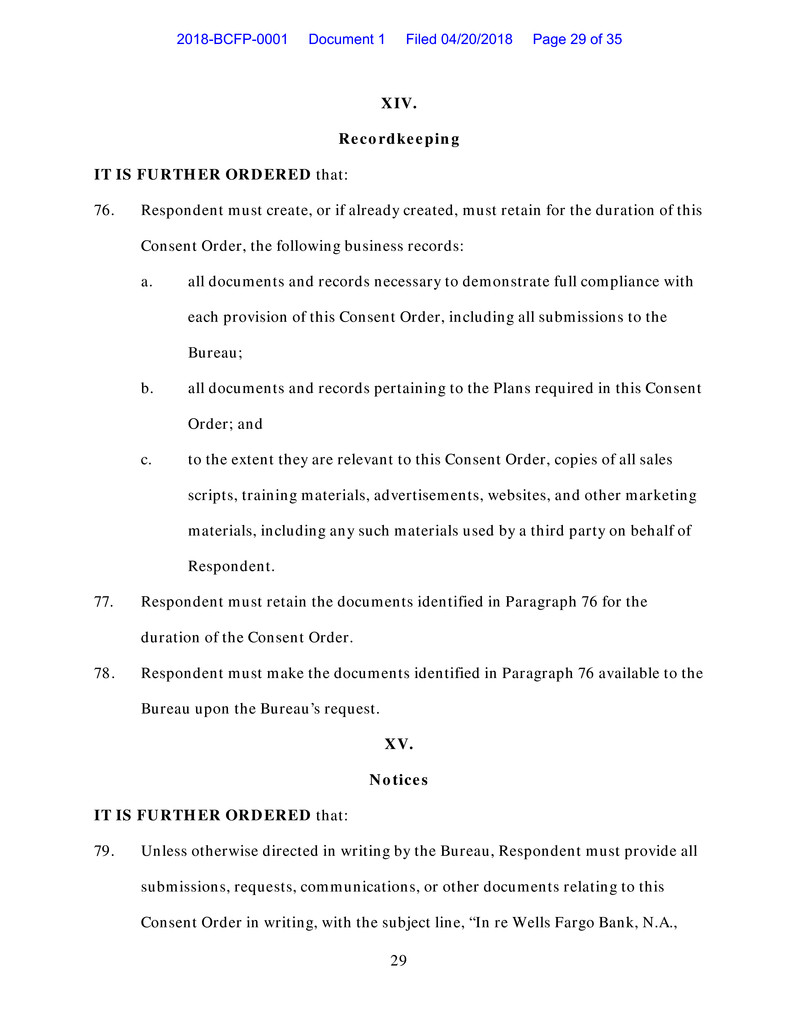
29 XIV. Recordkeeping IT IS FURTHER ORDERED that: 76. Respondent must create, or if already created, must retain for the duration of this Consent Order, the following business records: a. all documents and records necessary to demonstrate full compliance with each provision of this Consent Order, including all submissions to the Bureau; b. all documents and records pertaining to the Plans required in this Consent Order; and c. to the extent they are relevant to this Consent Order, copies of all sales scripts, training materials, advertisements, websites, and other marketing materials, including any such materials used by a third party on behalf of Respondent. 77. Respondent must retain the documents identified in Paragraph 76 for the duration of the Consent Order. 78. Respondent must make the documents identified in Paragraph 76 available to the Bureau upon the Bureau’s request. XV. Notices IT IS FURTHER ORDERED that: 79. Unless otherwise directed in writing by the Bureau, Respondent must provide all submissions, requests, communications, or other documents relating to this Consent Order in writing, with the subject line, “In re Wells Fargo Bank, N.A., 2018-BCFP-0001 Document 1 Filed 04/20/2018 Page 29 of 35
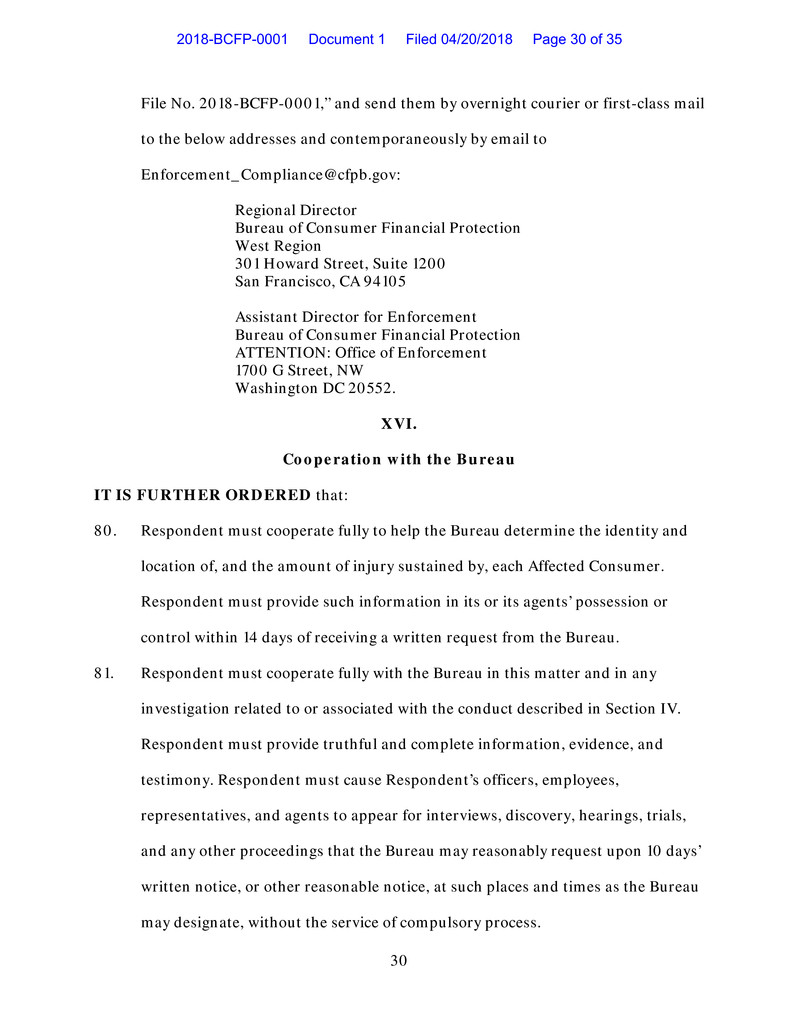
30 File No. 2018-BCFP-0001,” and send them by overnight courier or first-class mail to the below addresses and contemporaneously by email to Enforcement_Compliance@cfpb.gov: Regional Director Bureau of Consumer Financial Protection West Region 301 Howard Street, Suite 1200 San Francisco, CA 94105 Assistant Director for Enforcement Bureau of Consumer Financial Protection ATTENTION: Office of Enforcement 1700 G Street, NW Washington DC 20552. XVI. Cooperation with the Bureau IT IS FURTHER ORDERED that: 80. Respondent must cooperate fully to help the Bureau determine the identity and location of, and the amount of injury sustained by, each Affected Consumer. Respondent must provide such information in its or its agents’ possession or control within 14 days of receiving a written request from the Bureau. 81. Respondent must cooperate fully with the Bureau in this matter and in any investigation related to or associated with the conduct described in Section IV. Respondent must provide truthful and complete information, evidence, and testimony. Respondent must cause Respondent’s officers, employees, representatives, and agents to appear for interviews, discovery, hearings, trials, and any other proceedings that the Bureau may reasonably request upon 10 days’ written notice, or other reasonable notice, at such places and times as the Bureau may designate, without the service of compulsory process. 2018-BCFP-0001 Document 1 Filed 04/20/2018 Page 30 of 35
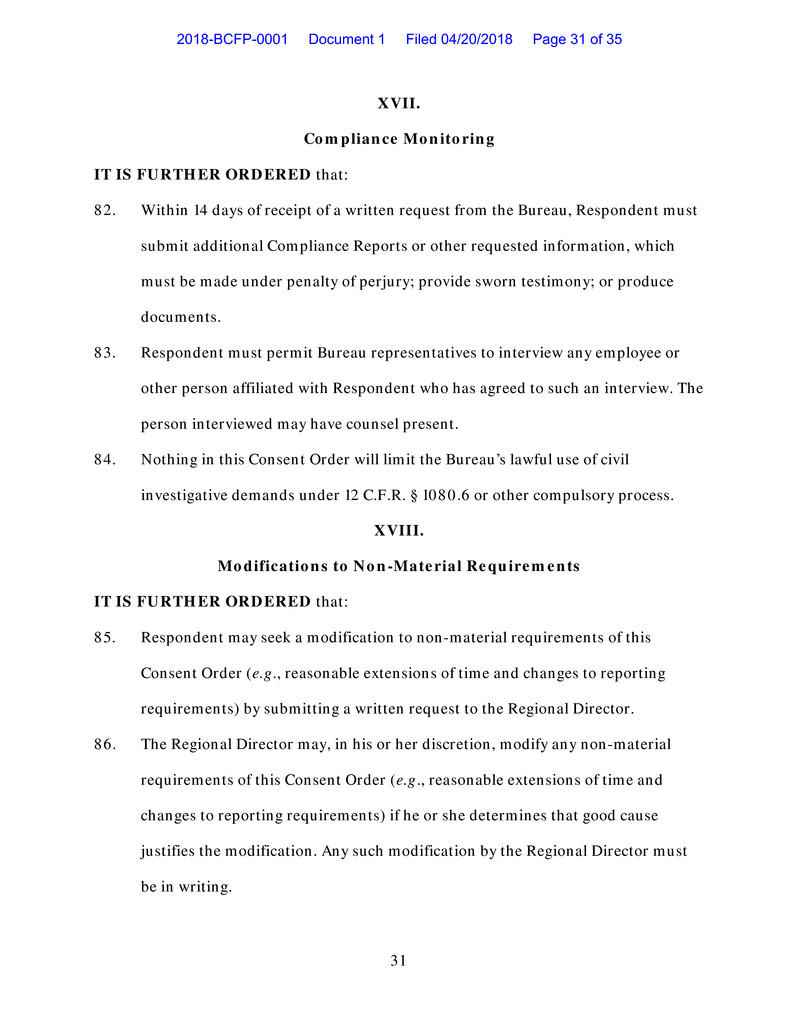
31 XVII. Compliance Monitoring IT IS FURTHER ORDERED that: 82. Within 14 days of receipt of a written request from the Bureau, Respondent must submit additional Compliance Reports or other requested information, which must be made under penalty of perjury; provide sworn testimony; or produce documents. 83. Respondent must permit Bureau representatives to interview any employee or other person affiliated with Respondent who has agreed to such an interview. The person interviewed may have counsel present. 84. Nothing in this Consent Order will limit the Bureau’s lawful use of civil investigative demands under 12 C.F.R. § 1080.6 or other compulsory process. XVIII. Modifications to Non-Material Requirements IT IS FURTHER ORDERED that: 85. Respondent may seek a modification to non-material requirements of this Consent Order (e.g., reasonable extensions of time and changes to reporting requirements) by submitting a written request to the Regional Director. 86. The Regional Director may, in his or her discretion, modify any non-material requirements of this Consent Order (e.g., reasonable extensions of time and changes to reporting requirements) if he or she determines that good cause justifies the modification. Any such modification by the Regional Director must be in writing. 2018-BCFP-0001 Document 1 Filed 04/20/2018 Page 31 of 35
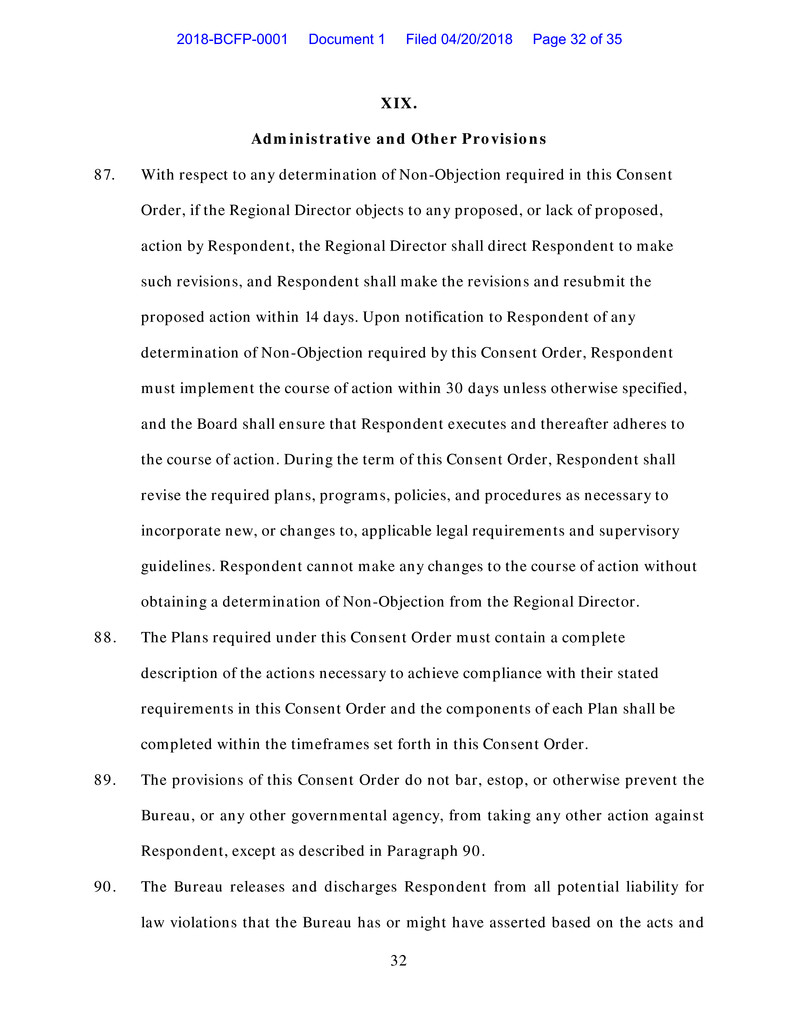
32 XIX. Administrative and Other Provisions 87. With respect to any determination of Non-Objection required in this Consent Order, if the Regional Director objects to any proposed, or lack of proposed, action by Respondent, the Regional Director shall direct Respondent to make such revisions, and Respondent shall make the revisions and resubmit the proposed action within 14 days. Upon notification to Respondent of any determination of Non-Objection required by this Consent Order, Respondent must implement the course of action within 30 days unless otherwise specified, and the Board shall ensure that Respondent executes and thereafter adheres to the course of action. During the term of this Consent Order, Respondent shall revise the required plans, programs, policies, and procedures as necessary to incorporate new, or changes to, applicable legal requirements and supervisory guidelines. Respondent cannot make any changes to the course of action without obtaining a determination of Non-Objection from the Regional Director. 88. The Plans required under this Consent Order must contain a complete description of the actions necessary to achieve compliance with their stated requirements in this Consent Order and the components of each Plan shall be completed within the timeframes set forth in this Consent Order. 89. The provisions of this Consent Order do not bar, estop, or otherwise prevent the Bureau, or any other governmental agency, from taking any other action against Respondent, except as described in Paragraph 90. 90. The Bureau releases and discharges Respondent from all potential liability for law violations that the Bureau has or might have asserted based on the acts and 2018-BCFP-0001 Document 1 Filed 04/20/2018 Page 32 of 35
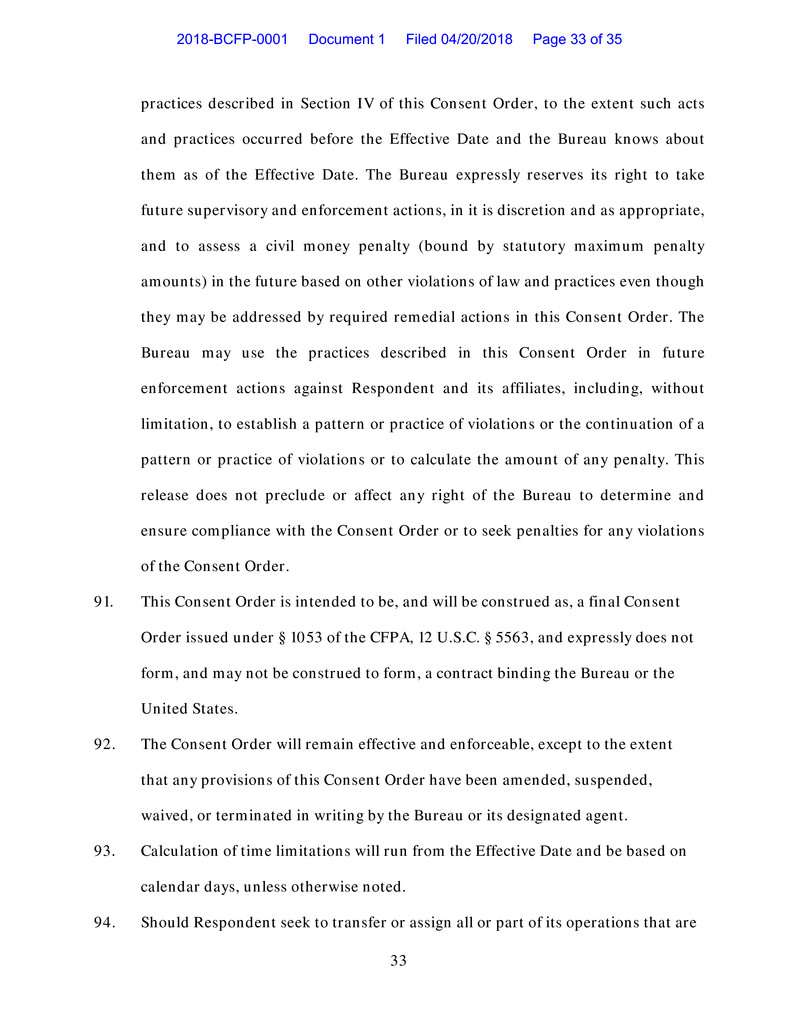
33 practices described in Section IV of this Consent Order, to the extent such acts and practices occurred before the Effective Date and the Bureau knows about them as of the Effective Date. The Bureau expressly reserves its right to take future supervisory and enforcement actions, in it is discretion and as appropriate, and to assess a civil money penalty (bound by statutory maximum penalty amounts) in the future based on other violations of law and practices even though they may be addressed by required remedial actions in this Consent Order. The Bureau may use the practices described in this Consent Order in future enforcement actions against Respondent and its affiliates, including, without limitation, to establish a pattern or practice of violations or the continuation of a pattern or practice of violations or to calculate the amount of any penalty. This release does not preclude or affect any right of the Bureau to determine and ensure compliance with the Consent Order or to seek penalties for any violations of the Consent Order. 91. This Consent Order is intended to be, and will be construed as, a final Consent Order issued under § 1053 of the CFPA, 12 U.S.C. § 5563, and expressly does not form, and may not be construed to form, a contract binding the Bureau or the United States. 92. The Consent Order will remain effective and enforceable, except to the extent that any provisions of this Consent Order have been amended, suspended, waived, or terminated in writing by the Bureau or its designated agent. 93. Calculation of time limitations will run from the Effective Date and be based on calendar days, unless otherwise noted. 94. Should Respondent seek to transfer or assign all or part of its operations that are 2018-BCFP-0001 Document 1 Filed 04/20/2018 Page 33 of 35
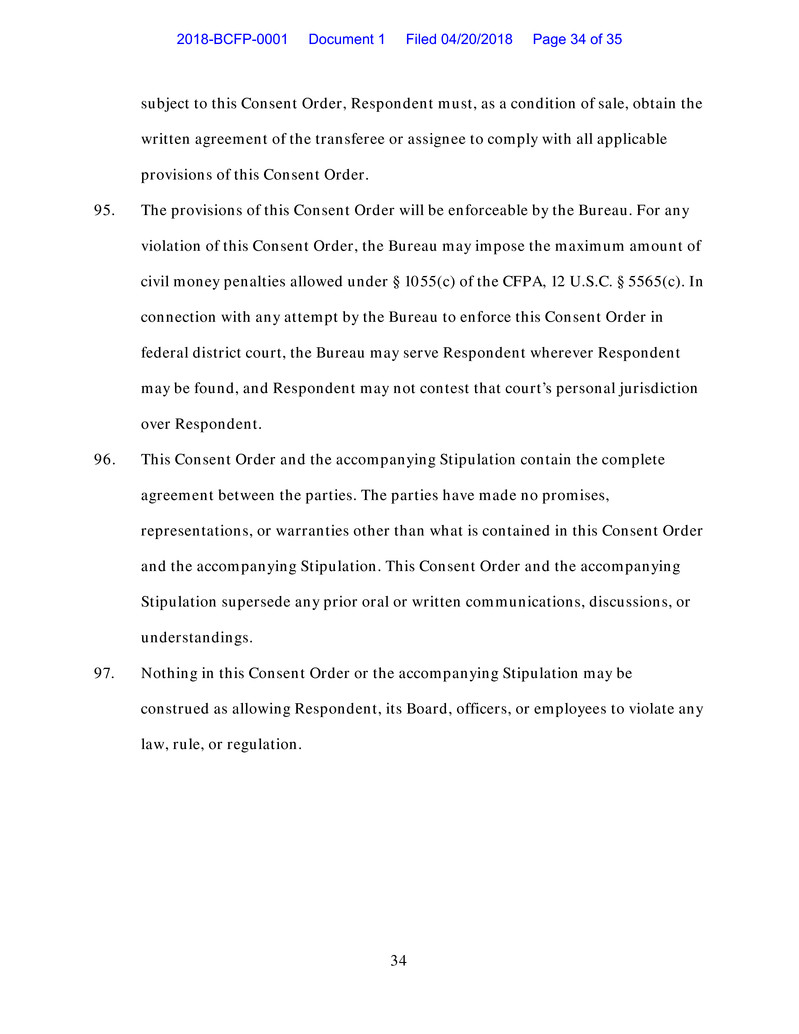
34 subject to this Consent Order, Respondent must, as a condition of sale, obtain the written agreement of the transferee or assignee to comply with all applicable provisions of this Consent Order. 95. The provisions of this Consent Order will be enforceable by the Bureau. For any violation of this Consent Order, the Bureau may impose the maximum amount of civil money penalties allowed under § 1055(c) of the CFPA, 12 U.S.C. § 5565(c). In connection with any attempt by the Bureau to enforce this Consent Order in federal district court, the Bureau may serve Respondent wherever Respondent may be found, and Respondent may not contest that court’s personal jurisdiction over Respondent. 96. This Consent Order and the accompanying Stipulation contain the complete agreement between the parties. The parties have made no promises, representations, or warranties other than what is contained in this Consent Order and the accompanying Stipulation. This Consent Order and the accompanying Stipulation supersede any prior oral or written communications, discussions, or understandings. 97. Nothing in this Consent Order or the accompanying Stipulation may be construed as allowing Respondent, its Board, officers, or employees to violate any law, rule, or regulation. 2018-BCFP-0001 Document 1 Filed 04/20/2018 Page 34 of 35
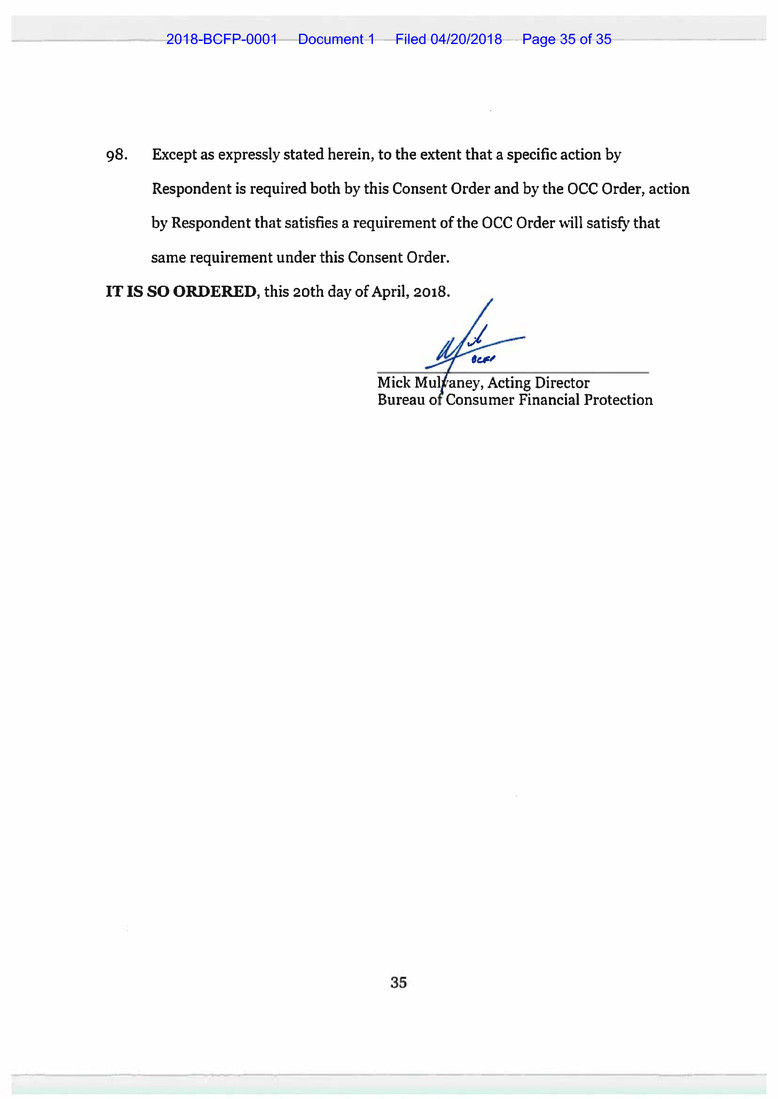
98. Except as expressly stated herein, to the extent that a specific action by Respondent is required both by this Consent Order and by the OCC Order, action by Respondent that satisfies a requirement of the OCC Order will satisfy that same requirement under this Consent Order. IT IS SO ORDERED, this 20th day of April, 2018. Mick Mui aney, Acting Director Bureau o Consumer Financial Protection 35 2018-BCFP-0001 Document 1 Filed 04/20/2018 Page 35 of 35


































